Pine trees offer unparalleled versatility in landscape design, serving as both architectural anchors and living sculptures that transform outdoor spaces year-round. These evergreen champions provide structure, privacy, and timeless beauty while adapting to various design styles from Japanese zen gardens to modern minimalist landscapes. With their diverse forms, textures, and growth patterns, pine trees create stunning focal points that enhance curb appeal and property value. Whether you're working with a small urban courtyard or expansive rural property, pine trees can be shaped, grouped, and integrated into complete landscape themes that reflect your personal style while requiring minimal maintenance once established.
1. Japanese Pine Tree Cloud Pruning Garden
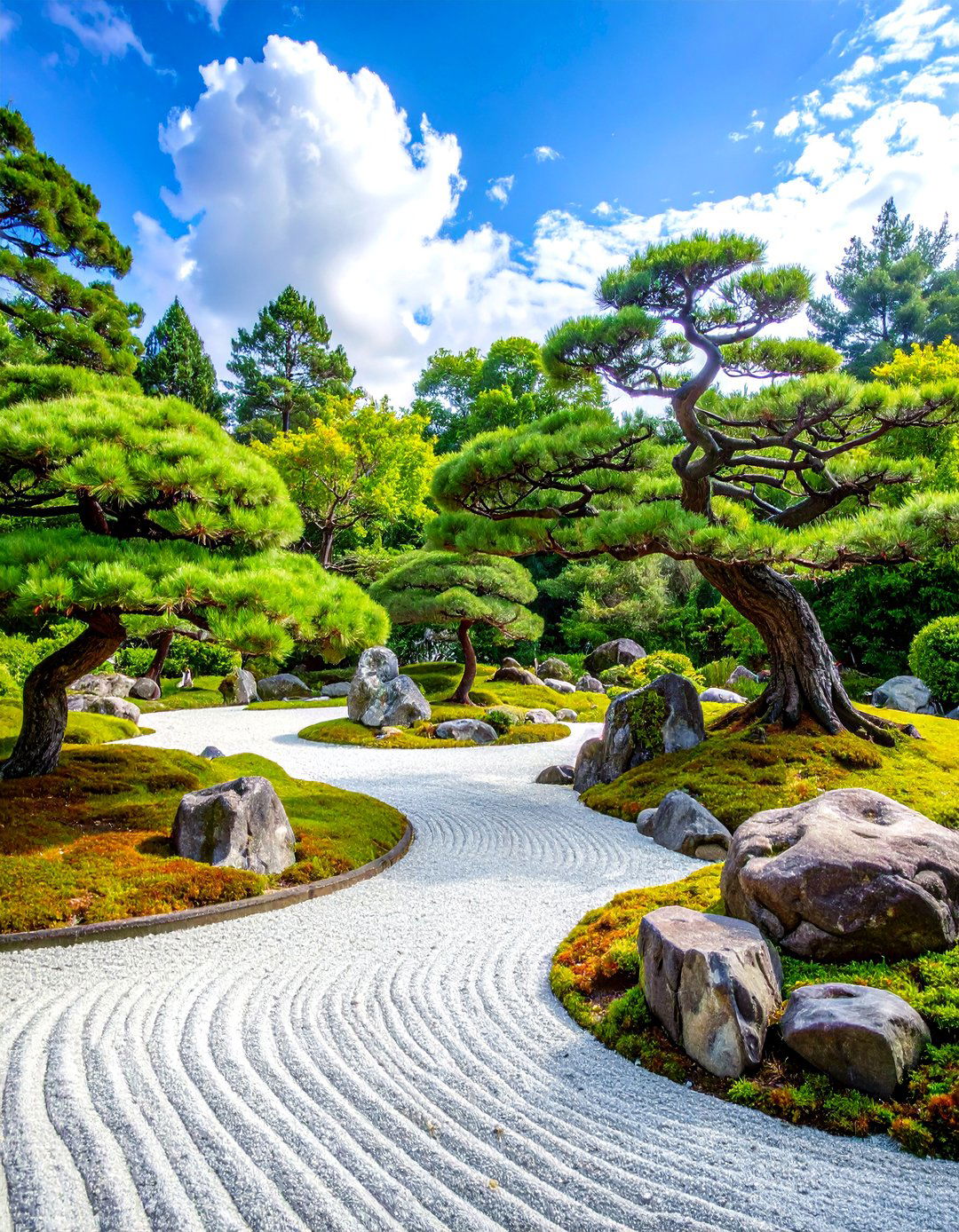
Japanese pine trees are often cloud pruned, which is a technique that creates rounded cloudlike shapes on each branch, giving them the well-known nickname of "cloud trees". This traditional niwaki approach transforms ordinary pine trees into living sculptures that embody centuries of horticultural artistry. The elegant lateral branch structure produced by pruning reveals graceful curves and creates an open, contemplative atmosphere. Complement cloud-pruned pines with carefully raked gravel, strategically placed stones, and low-growing moss to create an authentic Japanese garden experience. The interplay of different heights adds depth and creates perceptive scale that fades the boundary between garden and landscape. This design requires patience and skilled maintenance but rewards with timeless elegance that becomes more beautiful with age.
2. Modern Pine Tree Minimalist Landscape

Contemporary design embraces pine trees as architectural elements that provide clean lines and geometric forms. Tall and stately, pine trees have a powerful character-defining presence in a landscape. Select columnar varieties like Austrian pine or pencil-point junipers to create vertical emphasis against horizontal hardscape elements. For modern gardens, opt for sleek, minimalist containers that complement the clean lines of contemporary design. Surround with concrete pavers, steel planters, and ornamental grasses for texture contrast. The key lies in restraint—fewer, carefully chosen specimens create more impact than crowded plantings. Stylistically, minimalist designs with naturalistic planting schemes and organic shapes dominate, blending aesthetics with functionality. Incorporate subtle lighting to highlight pine silhouettes during evening hours, creating dramatic shadows and emphasizing the trees' sculptural qualities.
3. Xeriscape Pine Tree Water-Wise Garden
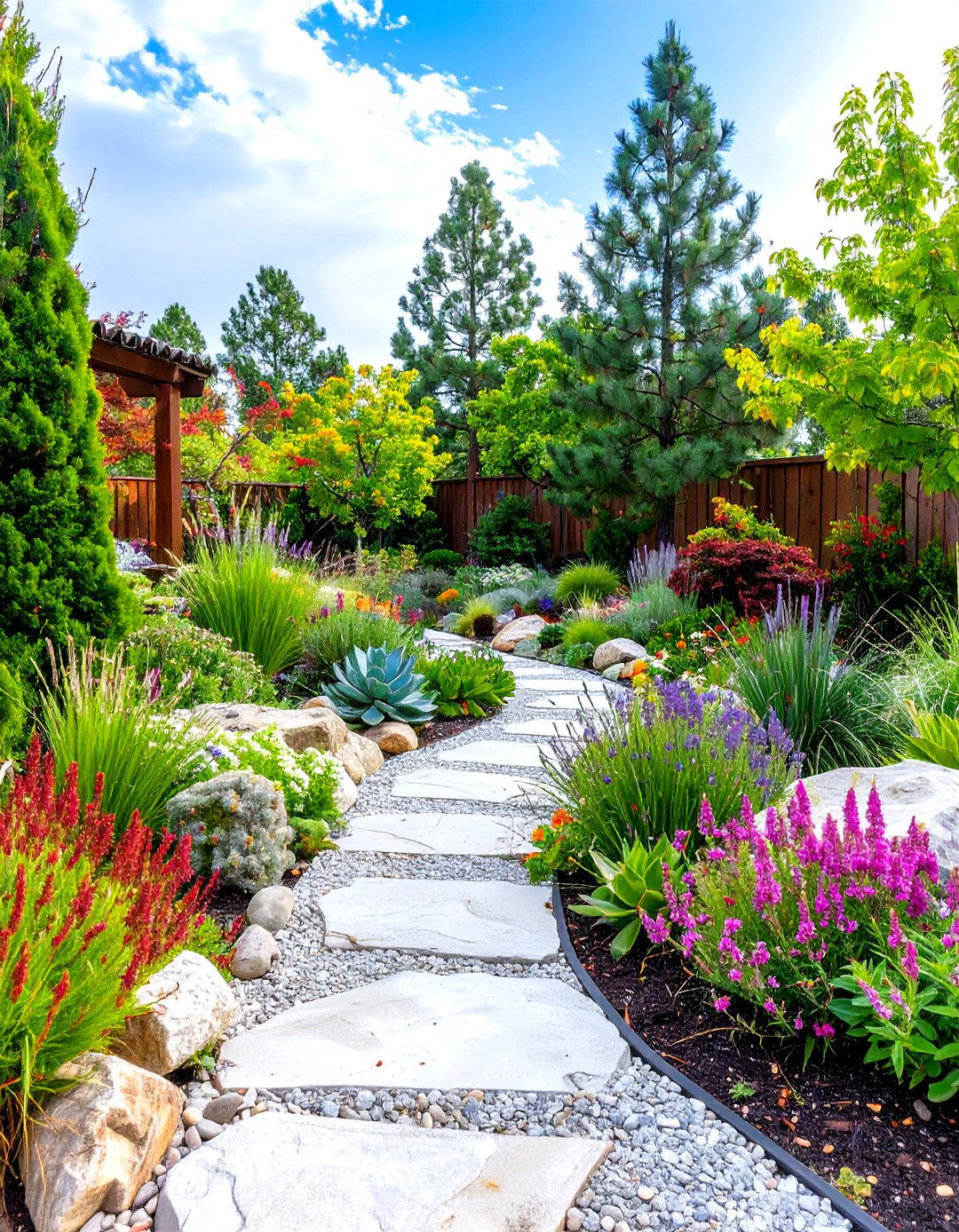
Xeriscaping champions water conservation by incorporating drought tolerant plants and smart irrigation methods, reducing water consumption by 50-70%. Design a sustainable landscape featuring drought-resistant pine varieties like Ponderosa pine or Austrian pine as anchor plants. Plant suggestions include ornamental grasses, trees, and others with distinct shapes that establish standout elements to anchor the visual design. Group pines with native succulents, ornamental grasses, and drought-tolerant perennials in hydrozones based on water needs. Use rocks, gravel, and mulch to reduce water evaporation and add interest to your garden. This approach creates a resilient landscape that thrives in arid conditions while maintaining year-round beauty. Select from a variety of trees and plants that grow with minimal effort in your region while elevating the aesthetic of your yard.
4. Pine Tree Privacy Screen Boundary
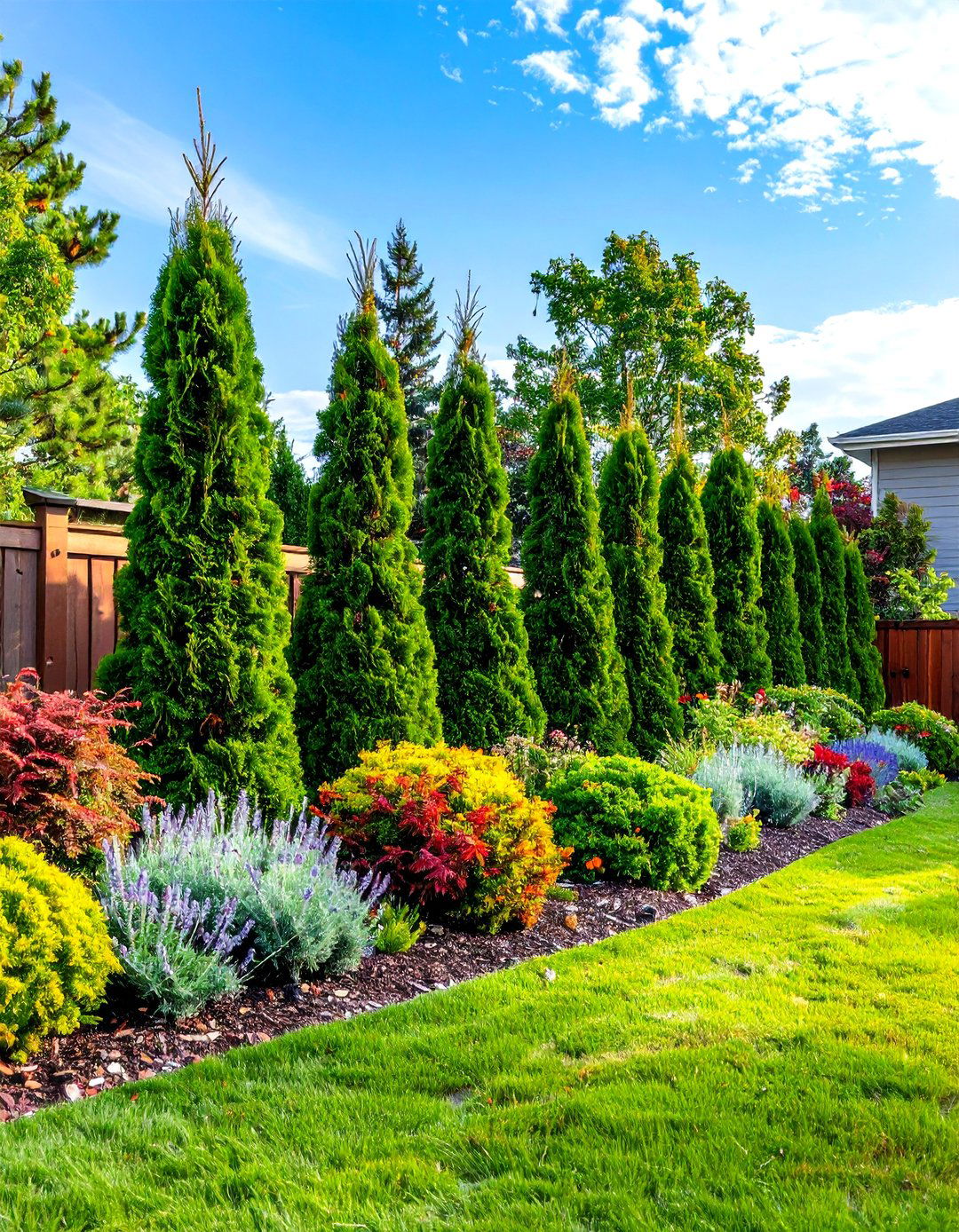
To create an effective privacy screen, plant tall pine varieties in a staggered row with recommended spacing of 6-8 feet apart for optimal coverage. This living barrier provides natural seclusion while reducing noise pollution and creating intimate outdoor spaces. Choose fast-growing varieties like Eastern White Pine or Leyland Cypress for quicker results. Evergreen trees are a cost-effective, attractive privacy solution, easily extending above fences and capable of blocking upper-story neighboring views. Layer the planting with mid-height shrubs and ground covers to create depth and prevent a wall-like appearance. For small spaces, consider columnar varieties that grow vertically without taking up much ground area. This design offers year-round screening while supporting local wildlife and creating microclimates within your property. Regular maintenance ensures dense growth and optimal privacy protection.
5. Pine Tree Cottage Garden Rustic Theme
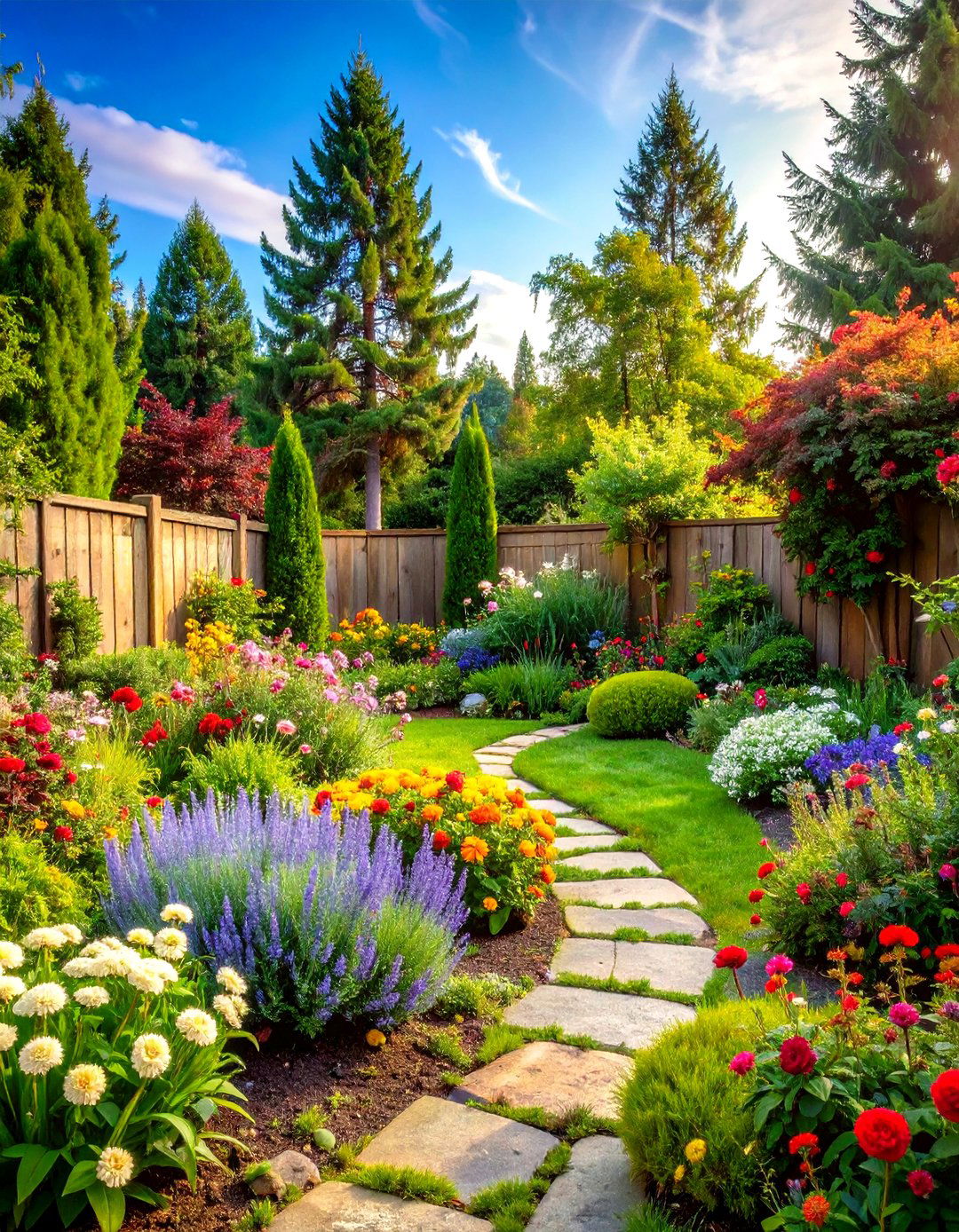
Embrace the charm of rural living by incorporating pine trees into a cottage-style landscape that combines rustic appeal with natural beauty. Pine trees create an almost mystical and cozy vibe in certain landscapes, with their needles giving off a unique and pleasant aroma. Plant dwarf pine varieties among perennial flowers, herbs, and climbing roses to create layered, informal plantings. Use acidic pine straw as mulch in garden beds of acid-loving plants including azaleas, camellias, gardenias and ferns. Incorporate weathered wooden elements and mossy accents to enhance the natural aesthetic. Add rustic features like split-rail fencing, stone pathways, and vintage garden accessories to complete the cottage ambiance. This design celebrates the natural growing patterns of pines while creating a welcoming, lived-in atmosphere that changes beautifully through the seasons.
6. Pine Tree Formal Geometric Landscape
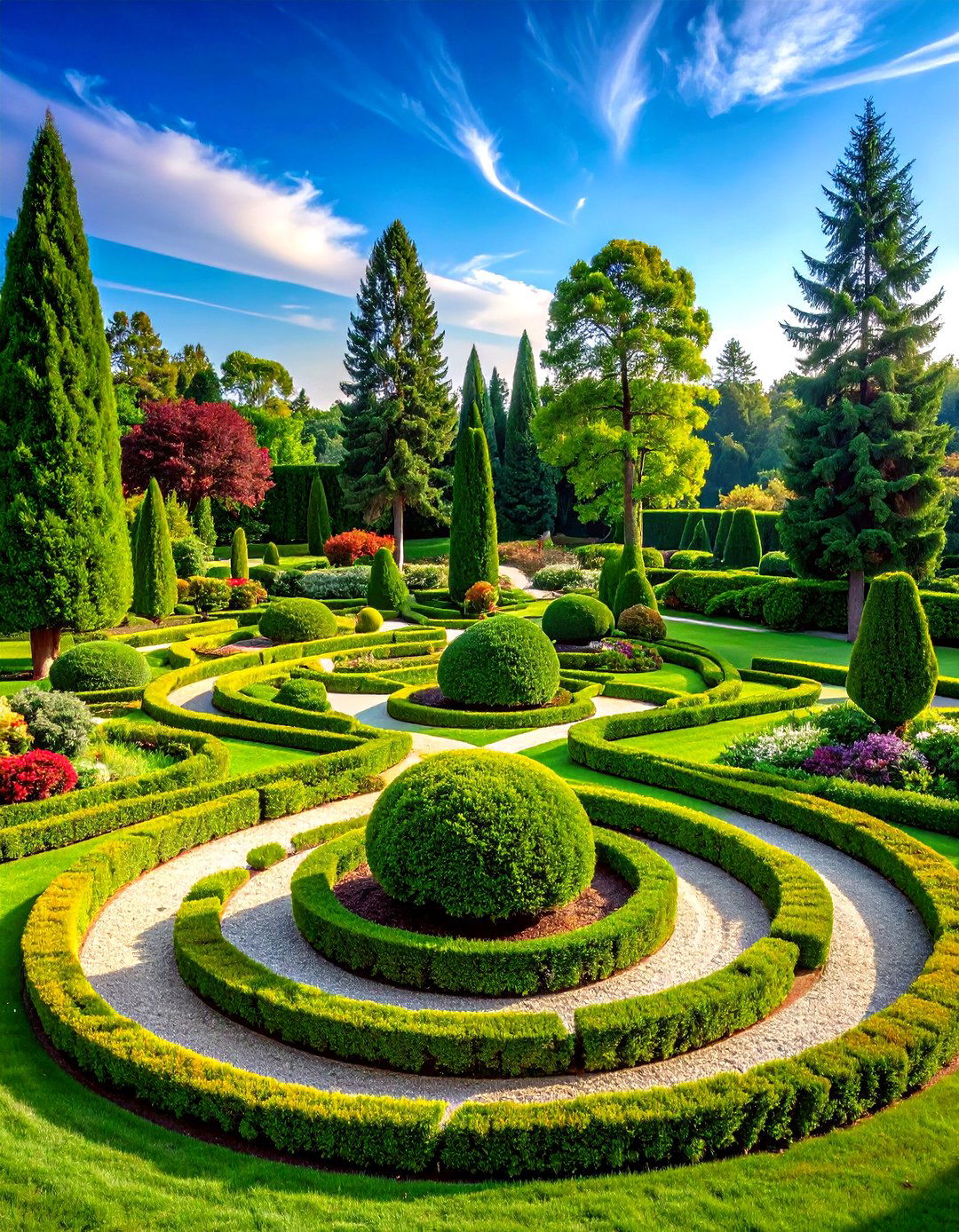
Transform your property with a sophisticated geometric design that uses pine trees as structured elements within formal patterns. The dwarf variety is short and stout, with a dense canopy that lets you shape these trees to elevate their appearance. Arrange pine trees in symmetrical patterns, creating defined borders and focal points within geometric garden beds. Tree pruning decreases the plant's size and beautifully shapes the tree branches, adding a unique, Bonsai-like look to yard landscaping. Use boxwood hedging, manicured lawn areas, and precisely placed hardscape elements to emphasize the formal structure. Design ideas for traditional landscaping incorporate classic elements that create refined, elegant outdoor spaces. This approach requires regular maintenance but rewards with a timeless, estate-like appearance that enhances property value and creates impressive curb appeal throughout the year.
7. Pine Tree Alpine Rock Garden

Create a mountain-inspired landscape that showcases the natural affinity between pine trees and rocky terrain. Rock gardens exude a natural, rustic charm, and incorporating pine trees can elevate this aesthetic through xeriscaping techniques. Select smaller pine varieties and dwarf cultivars that complement boulder placements and stone arrangements. Use a collection of different sized rocks in your garden landscape to create visual interest and natural drainage. Incorporate alpine plants, sedums, and ornamental grasses that thrive in well-drained, rocky conditions. The way pine branches twist and grow is intriguing and creates quite the display in the landscape. This design mimics high-altitude environments while requiring minimal water and maintenance. Add gravel pathways and strategically placed seating to create contemplative spaces within the rocky landscape that celebrate the rugged beauty of mountain ecosystems.
8. Pine Tree Woodland Naturalistic Design
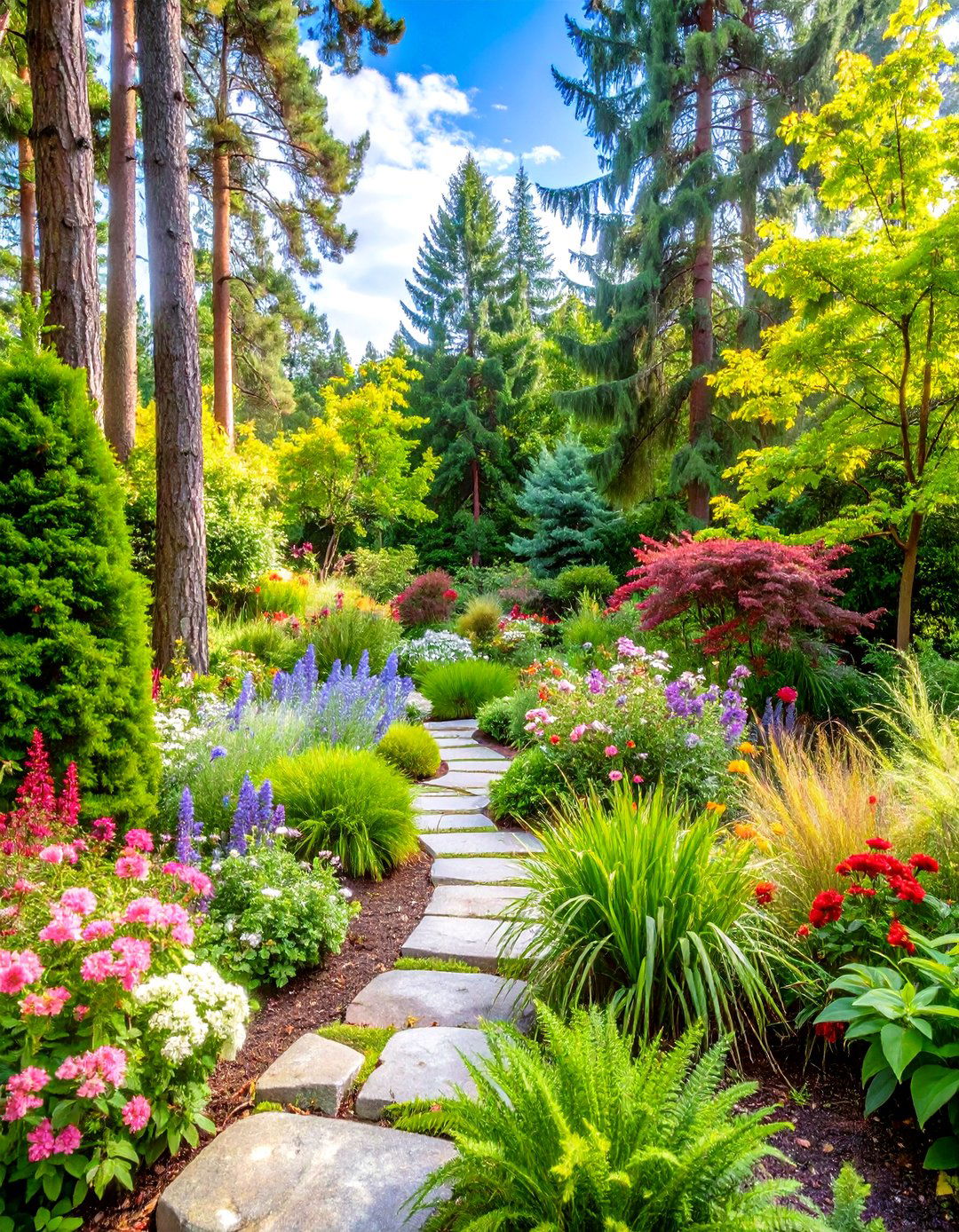
Let nature do its thing and take over your garden landscape, creating a rugged, organic appearance with naturally growing vegetation. Design a woodland-inspired landscape that celebrates the natural growing patterns of pine trees within a forest-like setting. One of the best companions for a cabin is a heavy planting of pine trees, with their looming height, fresh scent, and gorgeous aesthetic. Layer different pine species with native understory plants, ferns, and wildflowers to create a naturalistic ecosystem. Try growing shade tolerant groundcovers under the tree, including spotted deadnettle, moneywort, hosta, wild ginger, and astilbe. Leave the pine needles as they make great mulch. This approach requires minimal intervention while creating habitat for local wildlife and establishing a sustainable, self-maintaining landscape that evolves naturally over time.
9. Pine Tree Mediterranean Coastal Style
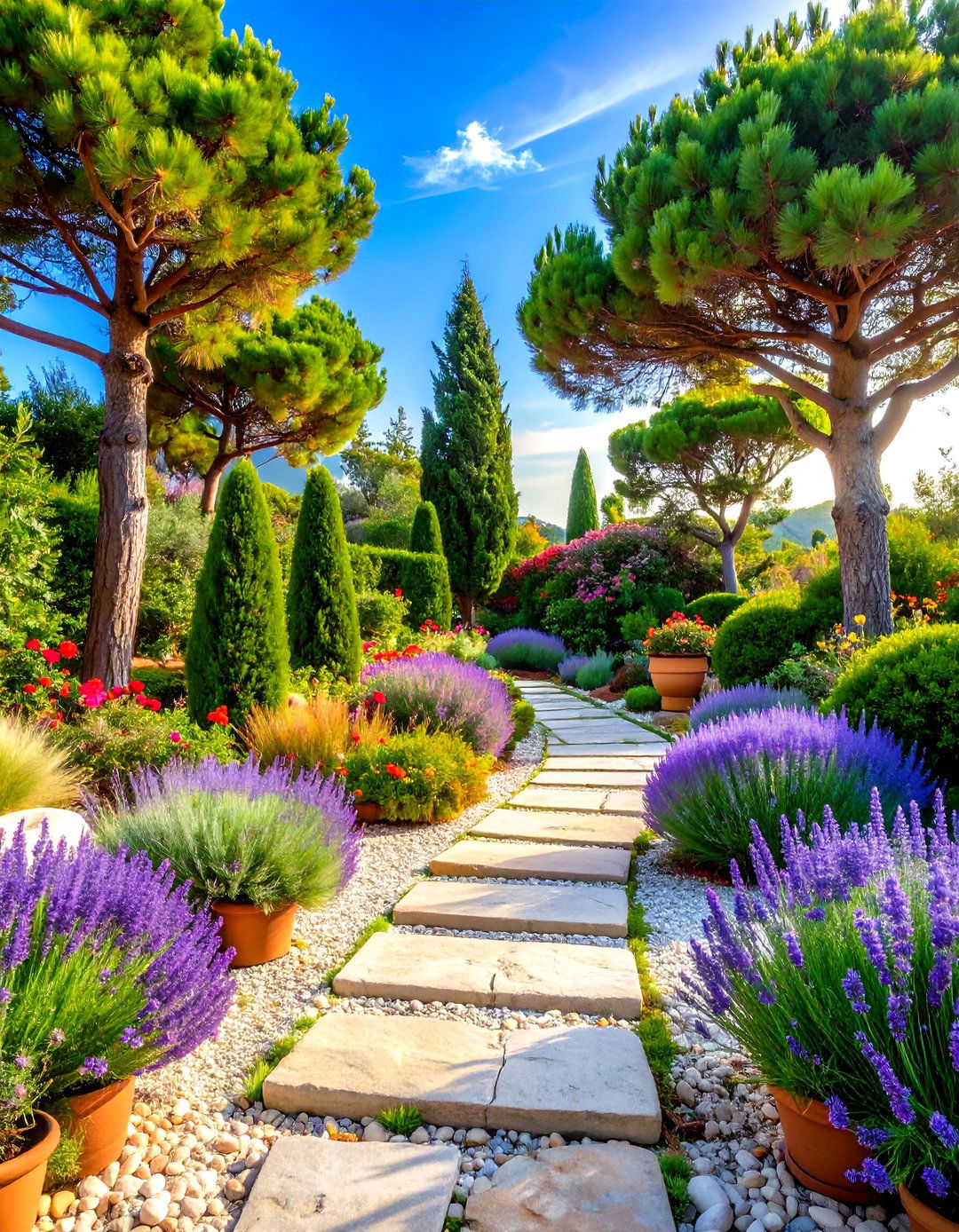
Capture the essence of Mediterranean coastal living with pine trees that evoke seaside landscapes and warm-climate elegance. Pinus thunbergii is native to seaside environments and grows best in full sun with tolerance for poor sandy soils, drought, and salty winds. These evergreen shrubs have their origins in the Mediterranean region and are well-suited to our dry summers. Combine maritime pines with drought-tolerant herbs like rosemary, lavender, and oregano. By using a palette of succulents, desert-acclimated palms, and unique native plants, this design gives off a tropical vibe while requiring very little water. Add gravel mulch, terracotta containers, and stone pathways to complete the Mediterranean aesthetic. Mediterranean Cypress adds a tall, narrow conifer that provides vertical elements. This design celebrates the relaxed, sun-drenched atmosphere of coastal regions while maintaining water-wise principles.
10. Pine Tree Bonsai-Inspired Container Garden
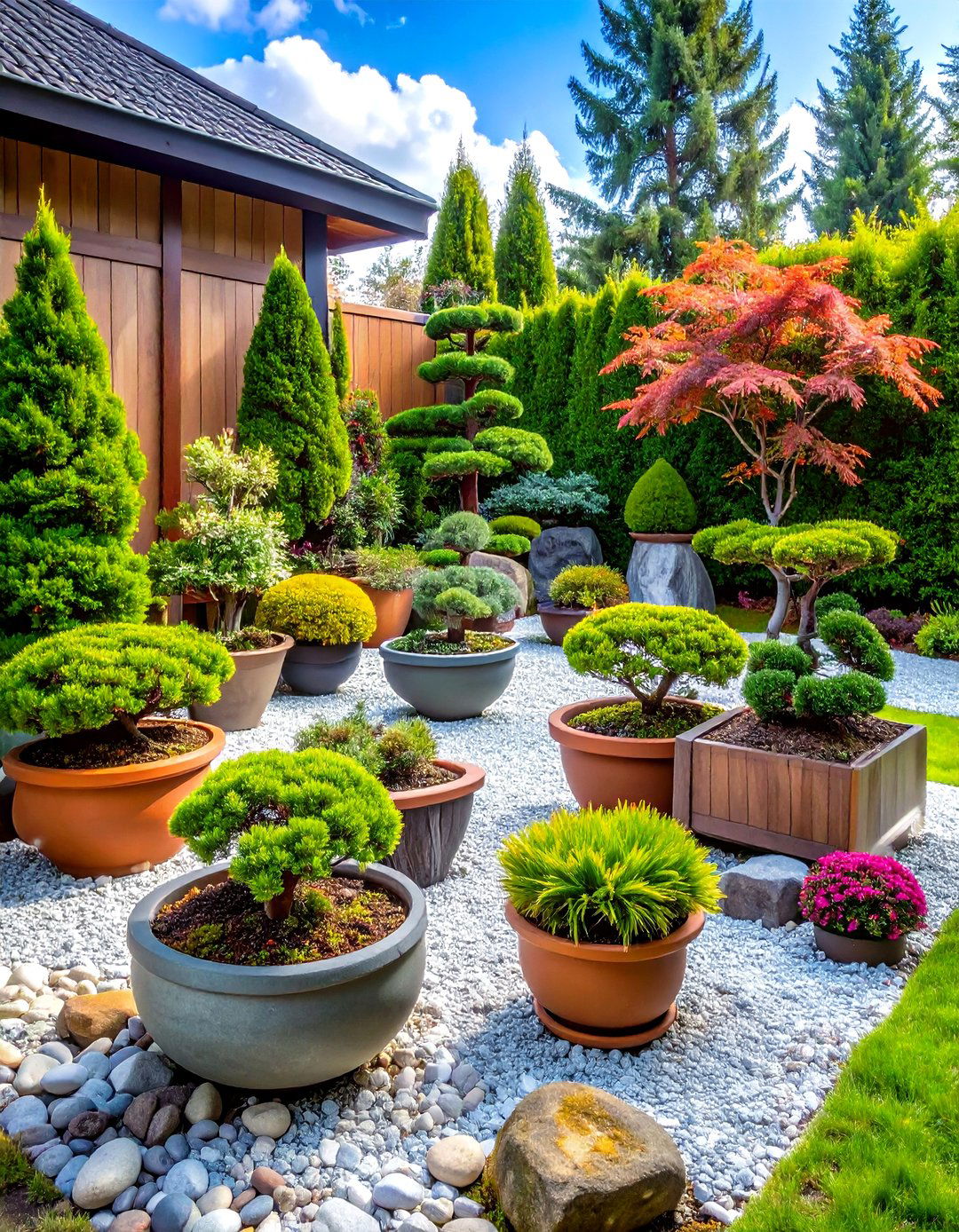
For small gardens, consider using dwarf varieties in containers to maximize small garden spaces. Create an intimate landscape using carefully selected pine trees in decorative containers that showcase the art of miniature tree cultivation. The practice of training miniature trees in containers, called bonsai, is known as a high art in Japan. Planting pine trees in raised containers brings more emphasis to the tree and makes for an awesome display. Choose slow-growing pine varieties and complement with moss, small rocks, and architectural containers. Use varied plant heights in stylish containers for an inviting space. This approach allows for precise control over growing conditions while creating focal points that can be rearranged seasonally. Bonsai pine trees can be strategically placed to evoke a sense of age and wisdom. Perfect for patios, courtyards, and small urban gardens.
11. Pine Tree Four-Season Interest Garden
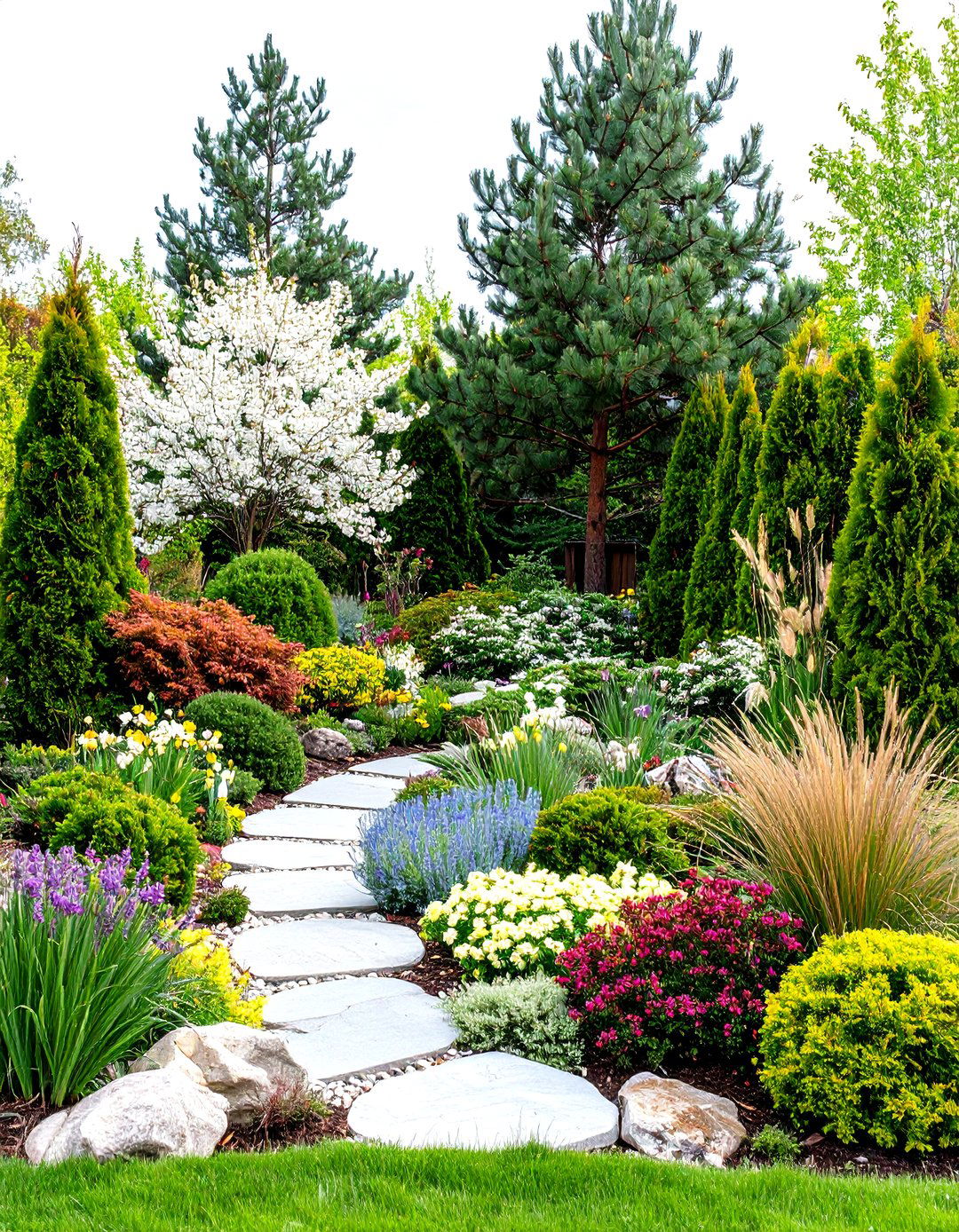
Design a landscape that celebrates the year-round beauty of pine trees while incorporating companion plants that provide seasonal color and texture changes. Pine trees look exquisite throughout the year, with each season providing its own unique touch to their appearance. Since pine trees are evergreen, they provide lush, vibrant green colors to your landscape all year long. Underplant with spring bulbs, summer perennials, and autumn-flowering plants to create continuous seasonal displays. Trees are carefully chosen and arranged for their autumn colors, with flowers carefully chosen by their season of flowering. During wintertime, when the clouds of pine trees are draped in snow, they're unforgettable sights to behold. Add berry-producing shrubs and ornamental grasses that provide winter interest alongside evergreen pine structure. This design ensures your landscape remains engaging throughout the year while pine trees provide consistent backbone structure.
12. Pine Tree Entrance Statement Landscape
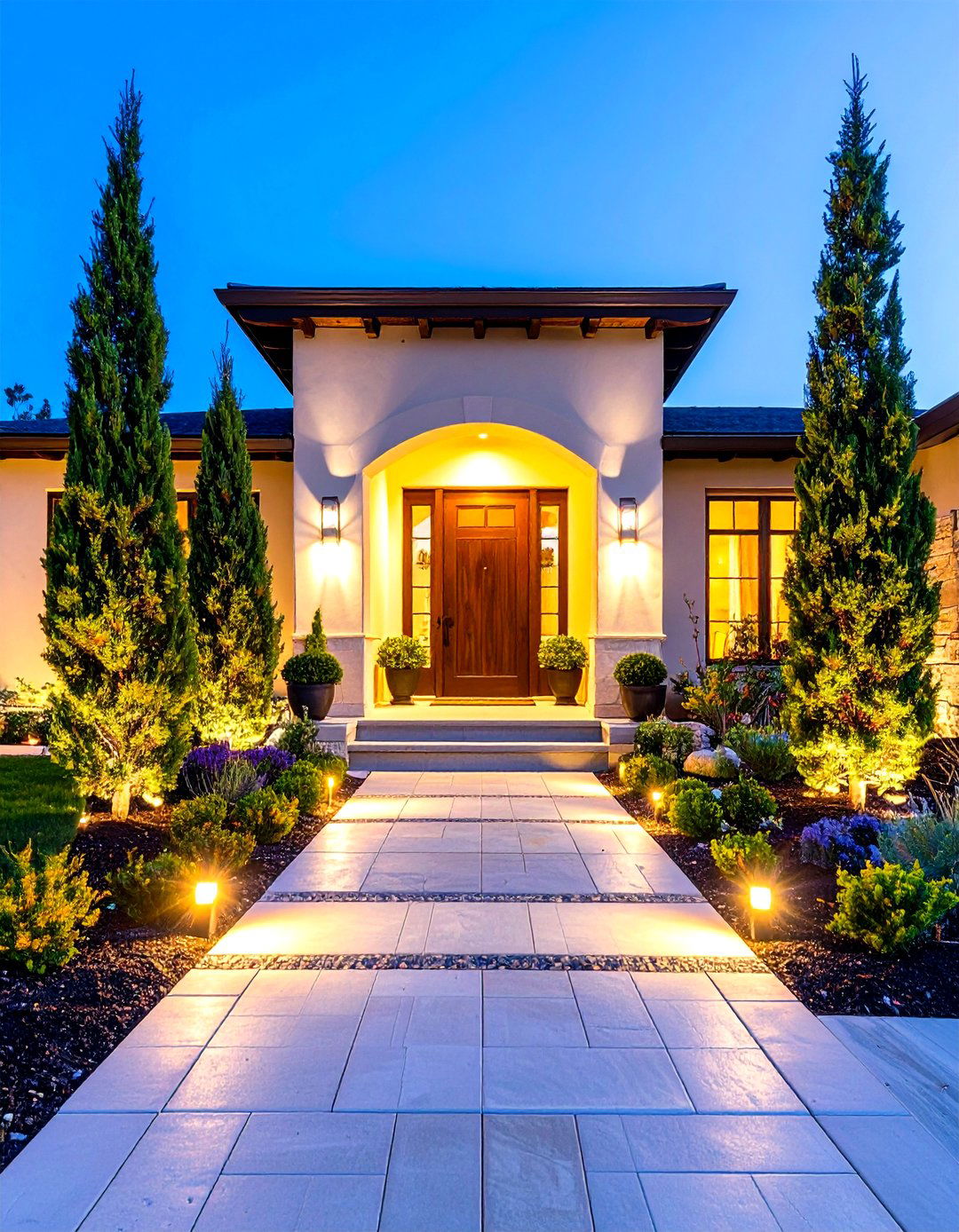
One easy way to landscape your front yard is by planting a large pine tree that serves as a show-stopping centerpiece since it can't be missed. Create a dramatic entrance that welcomes guests with the commanding presence of strategically placed pine trees. Large pine trees, such as the Ponderosa Pine, can provide a stately presence, while smaller varieties like the Bosnian Pine offer an eye-catching touch. Flanking patios, paths, and thresholds with trees is a classic strategy for adding grandeur to a landscape. You can make your house the focus by planting a few trees or shrubs on each side of your walkway. Layer with seasonal plantings and architectural lighting to create depth and visual interest. This tree species is a go-to option for those looking to step up their curb appeal. The result is an impressive entrance that establishes property character while providing year-round beauty and enhanced property value.
13. Pine Tree Zen Meditation Garden
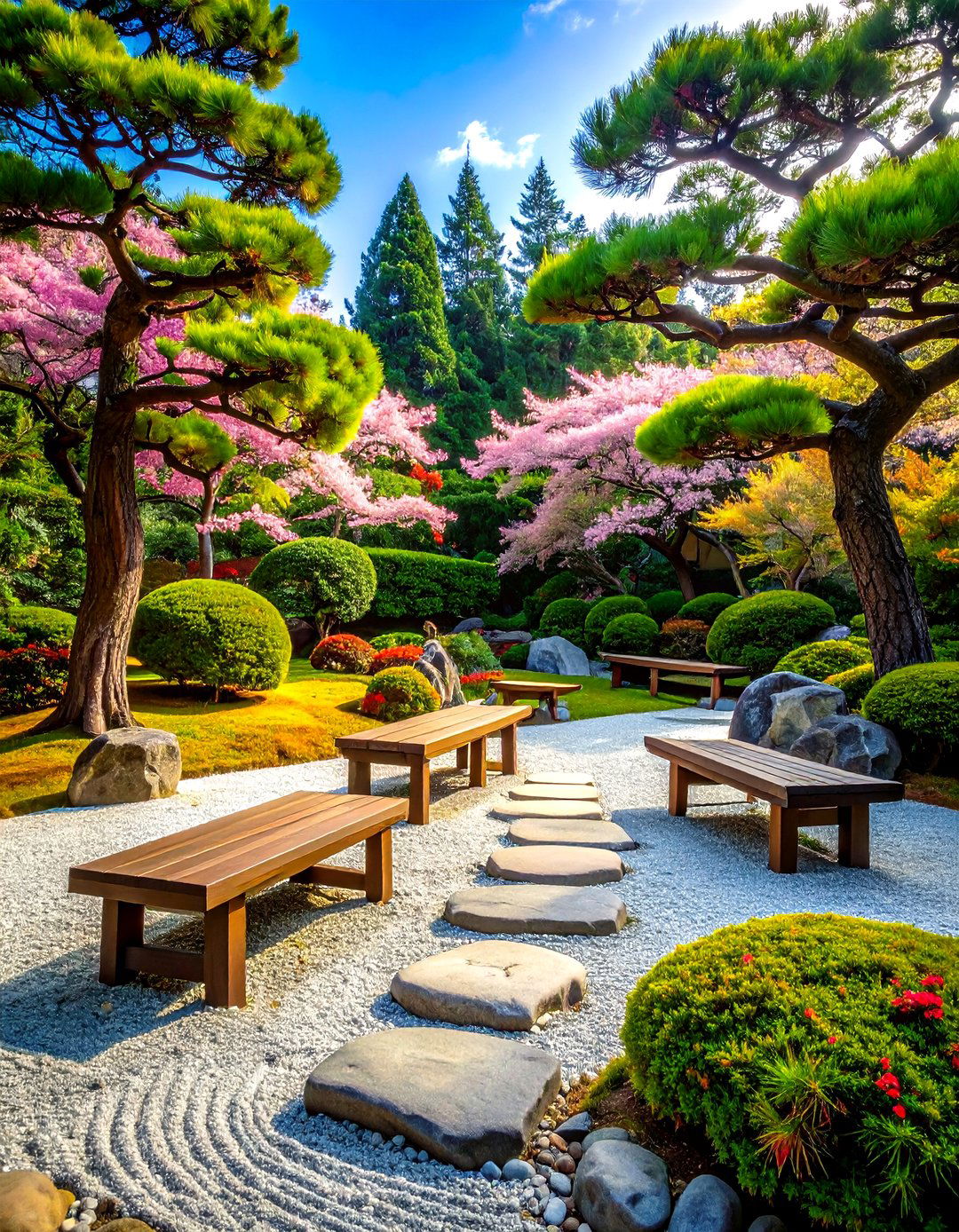
Gardens are being designed with relaxation in mind, incorporating spaces for meditation and intimate areas for gathering. Create a tranquil retreat centered around pine trees that promote mindfulness and peaceful contemplation. Pines are strongly associated with Japan's oldest religion, Shintoism, which views pines as capable of attracting the gods. Nothing in a Japanese garden is natural or left to chance; each plant is chosen according to aesthetic principles. Japanese gardens are not laid on straight axes but are carefully composed into scenes that contrast right angles. Incorporate raked gravel, stepping stones, and simple wooden benches to create meditative pathways. Cluster 3-5 trees of varying heights together to create a visually striking arrangement that invites exploration. This design emphasizes simplicity, balance, and the spiritual connection between humans and nature.
14. Pine Tree Windbreak Protection Landscape
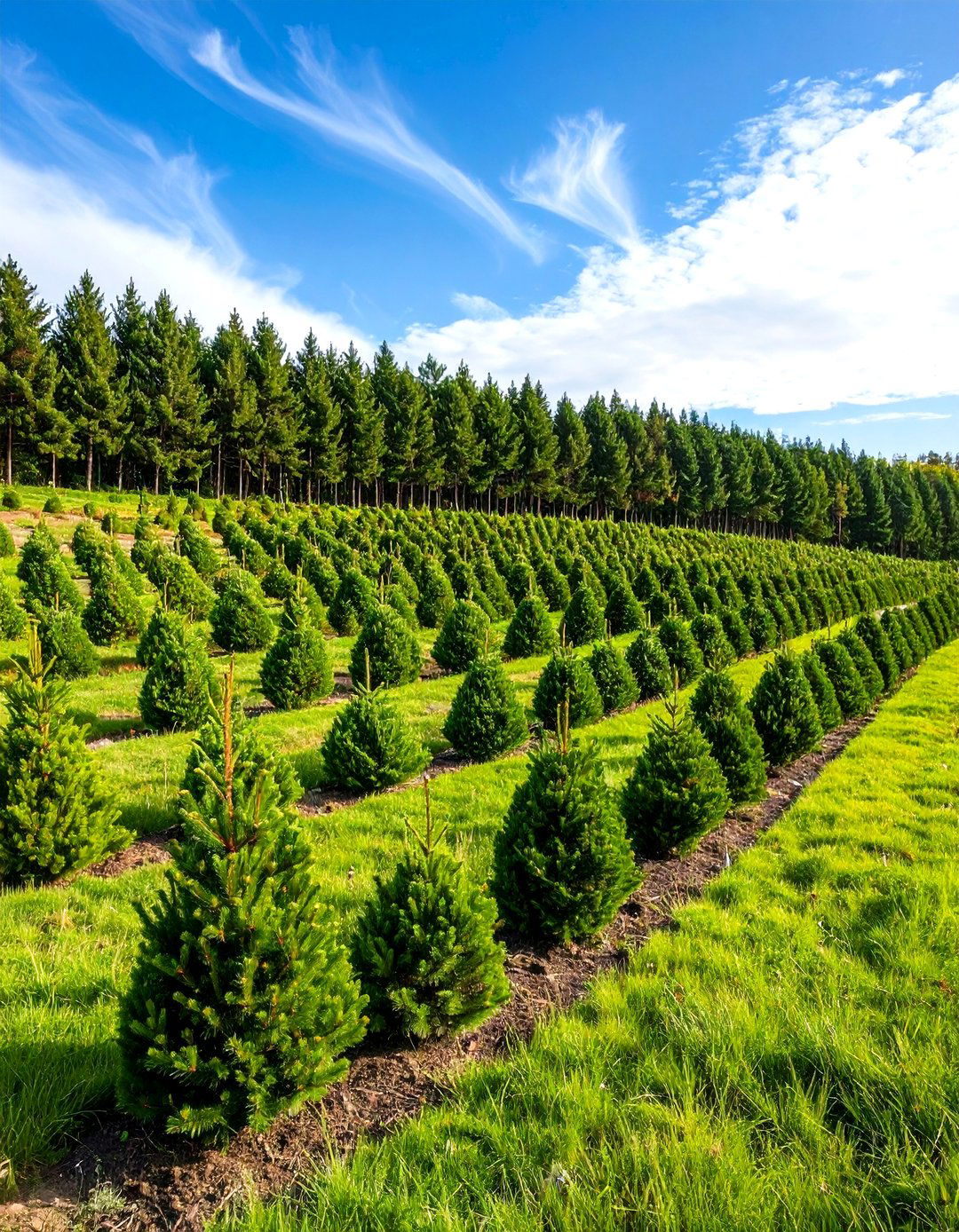
Define borders, add privacy, and provide seasonal interest with low-water and native shrub varieties. Establish a functional landscape that protects your property from harsh winds while creating microclimates for more delicate plants. The Swiss Mountain Pine grows quite wide, making it a great option for privacy around property lines. Create a line of trees around the property to get more privacy if desired. Plant multiple rows of pine trees at staggered heights to create an effective windbreak that reduces energy costs and protects gardens. Trees require assessment of site soil, drainage, and exposure before selecting appropriate species. Choose hardy varieties suited to your climate zone and complement with shrubs that benefit from wind protection. According to the USDA, the net cooling effect of a young, healthy tree is equivalent to ten room-size air conditioners. This design provides both environmental benefits and practical protection for your property.
15. Pine Tree Slope Erosion Control Design
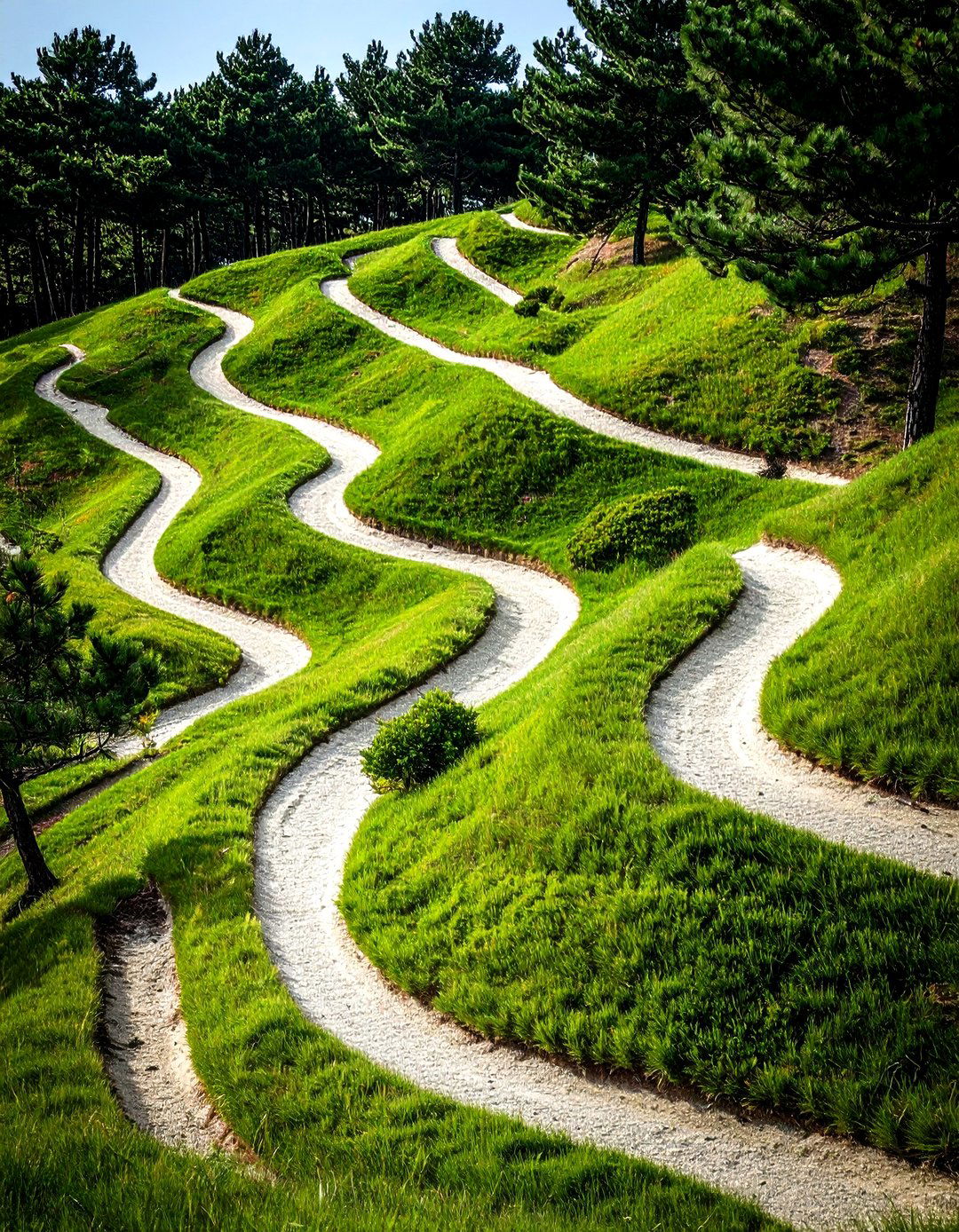
Transform challenging sloped terrain into a beautiful, functional landscape using pine trees as natural erosion control anchors. Choose groundcovers suitable for your climate and sun exposure that work alongside trees for stability. Choose plants that can control erosion on steep slopes, using lower growing groundcovers alongside established trees. Plant pine trees at strategic intervals to stabilize soil while creating visual interest on difficult terrain. Jack Pine is native to North America and well-suited for sandy and poor soils, able to withstand harsh conditions. Assess site soil, drainage and exposure before selecting trees and shrubs for long-term investment. Combine with native grasses and ground covers that spread naturally to prevent soil movement. Winding patterns through the landscape create intriguing visual flow while providing practical erosion control. This approach transforms problem areas into attractive, low-maintenance landscapes that provide environmental benefits.
16. Pine Tree Wildlife Habitat Garden
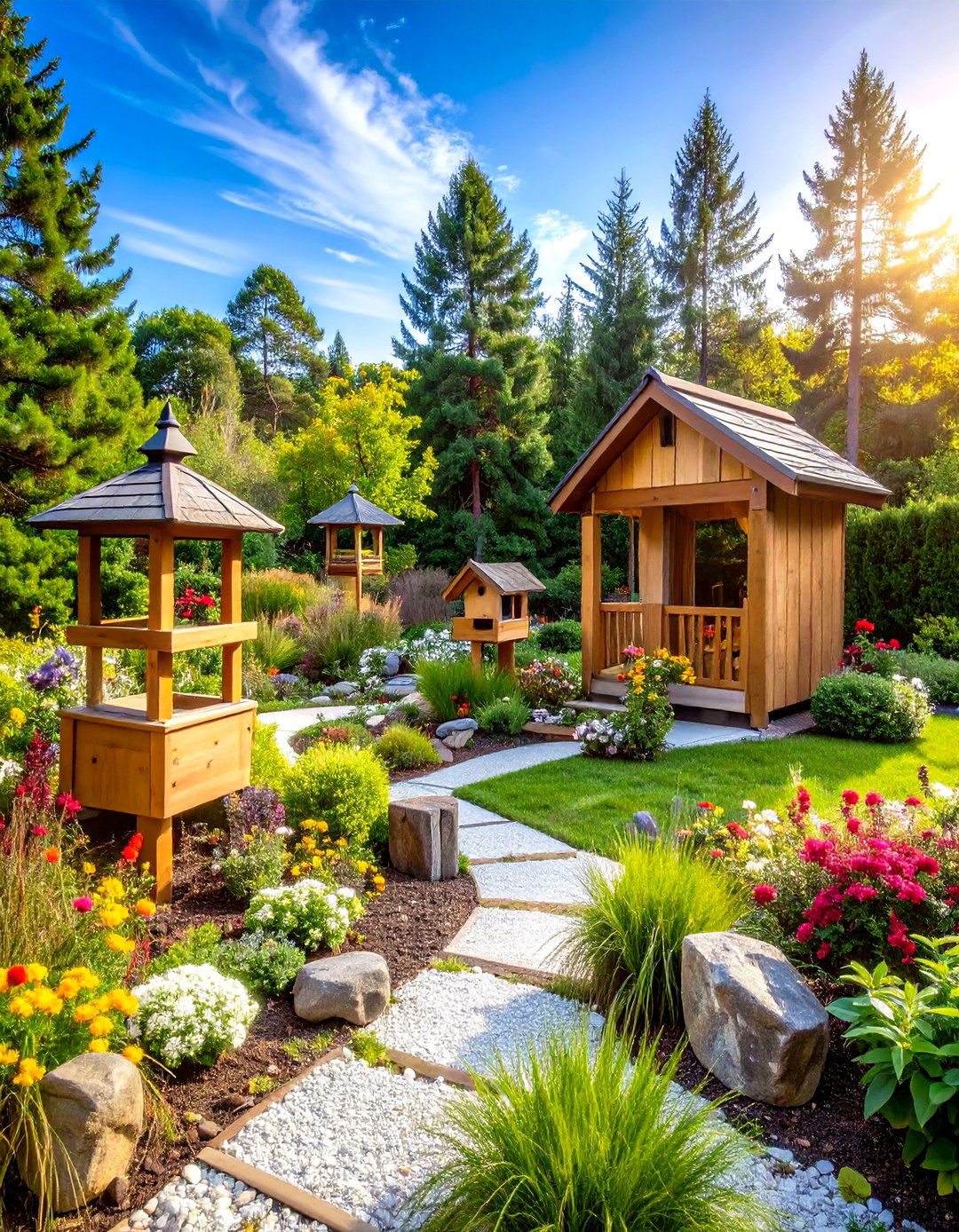
Create diverse, densely planted environments with trees, shrubs, grasses, and flowering perennials that support local ecosystems. Design a landscape that celebrates the symbiotic relationship between pine trees and native wildlife while creating a living ecosystem. Trees provide critical food, shelter, and nesting resources to insects and animals, offering life-saving refuge to migrating birds. Include shallow water sources and natural shelters like logs and rocks alongside nectar-rich plants. Choose native pine species that support local bird populations and beneficial insects. Avoid pesticides and select well-adapted native plants to maximize habitat benefits. Add bird feeders, nesting boxes, and native berry-producing plants to create a comprehensive wildlife sanctuary. Xeriscaping landscapes support local wildlife and increase biodiversity by creating sustainable habitats. This design provides year-round habitat while creating an engaging, ever-changing landscape that connects homeowners with nature.
17. Pine Tree Raised Bed Showcase Design

Planting pine trees in raised planters makes for an awesome display and great use of space, bringing more emphasis to the tree. Create dramatic landscape features using elevated plantings that showcase pine trees as architectural elements. Stack cinder blocks to make planters or beds for a contemporary look, with openings providing drainage. Landscape the entire container however you wish and incorporate all kinds of plant life. Design raised beds at varying heights to create visual interest and accommodate different pine varieties. In rustic gardens, consider incorporating natural stone or wood elements to enhance the organic feel. This approach allows for precise soil control while creating focal points that can be admired from multiple angles. This method enhances density and provides opportunities for creative plant combinations. Perfect for urban environments or areas with poor soil conditions, raised beds provide optimal growing conditions while creating striking landscape features.
18. Pine Tree Poolside Oasis Landscape
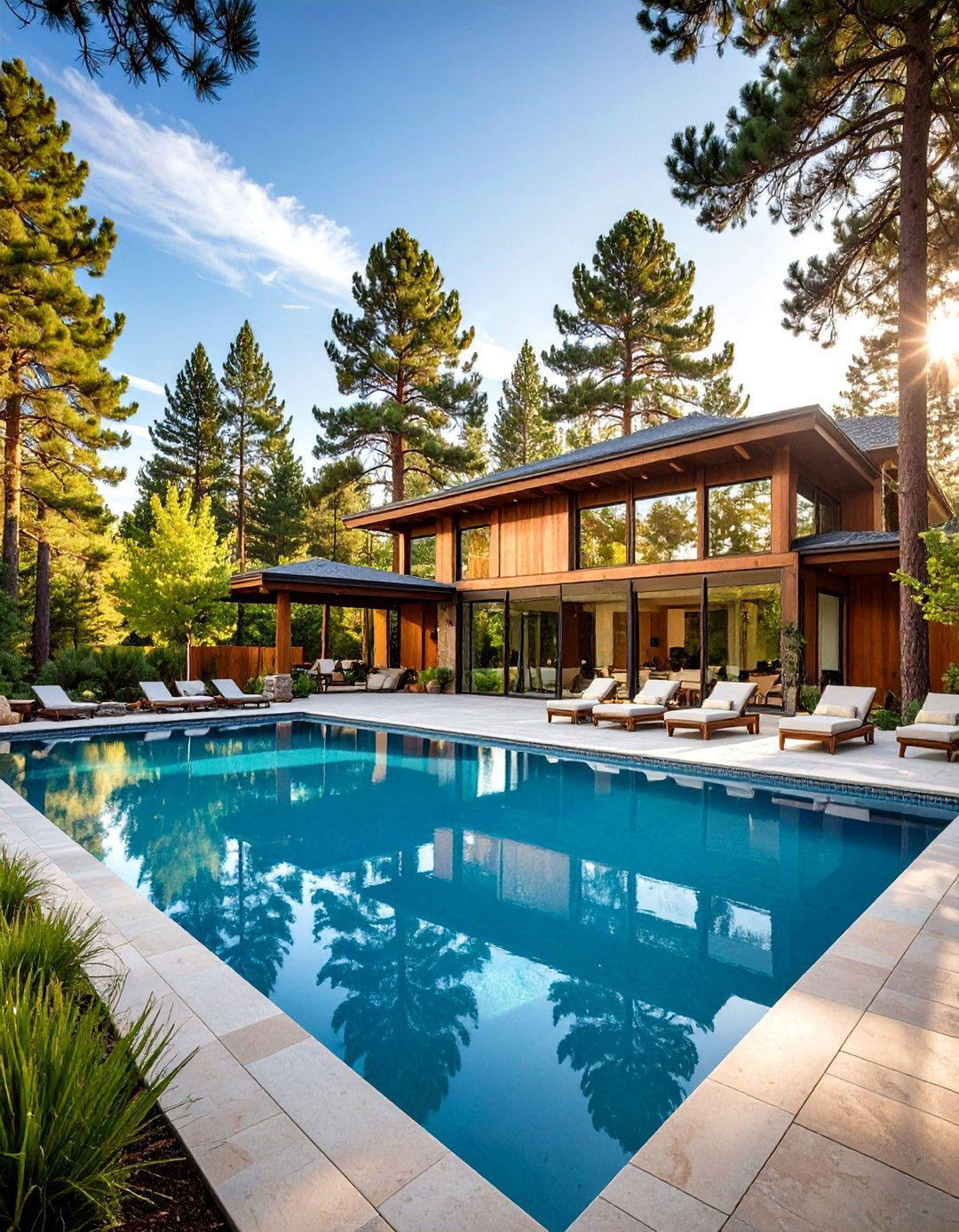
Pine trees shouldn't be overlooked for poolside plants as they add a nice pop and accentuate the pool well. Design a resort-style landscape that combines the cooling presence of pine trees with water features for ultimate relaxation. With their evergreen leaves, you'll never go a day without shade and a gorgeous tree to look at. Small ponds are a wonderful landscaping element to pair with pine trees, with soft blue hues complementing lush green. In this setting, pine trees also serve as a partial wind-blocking wall. Choose varieties that tolerate splashing and provide filtered shade without dropping excessive needles. Piru Queen Palm and other drought-tolerant palms can complement pine trees for tropical appeal. Add lounge areas, outdoor furniture, and container plants to create a complete outdoor living space. This design transforms your backyard into a year-round retreat that combines the serenity of evergreen trees with aquatic leisure.
19. Pine Tree Pathway Border Landscape
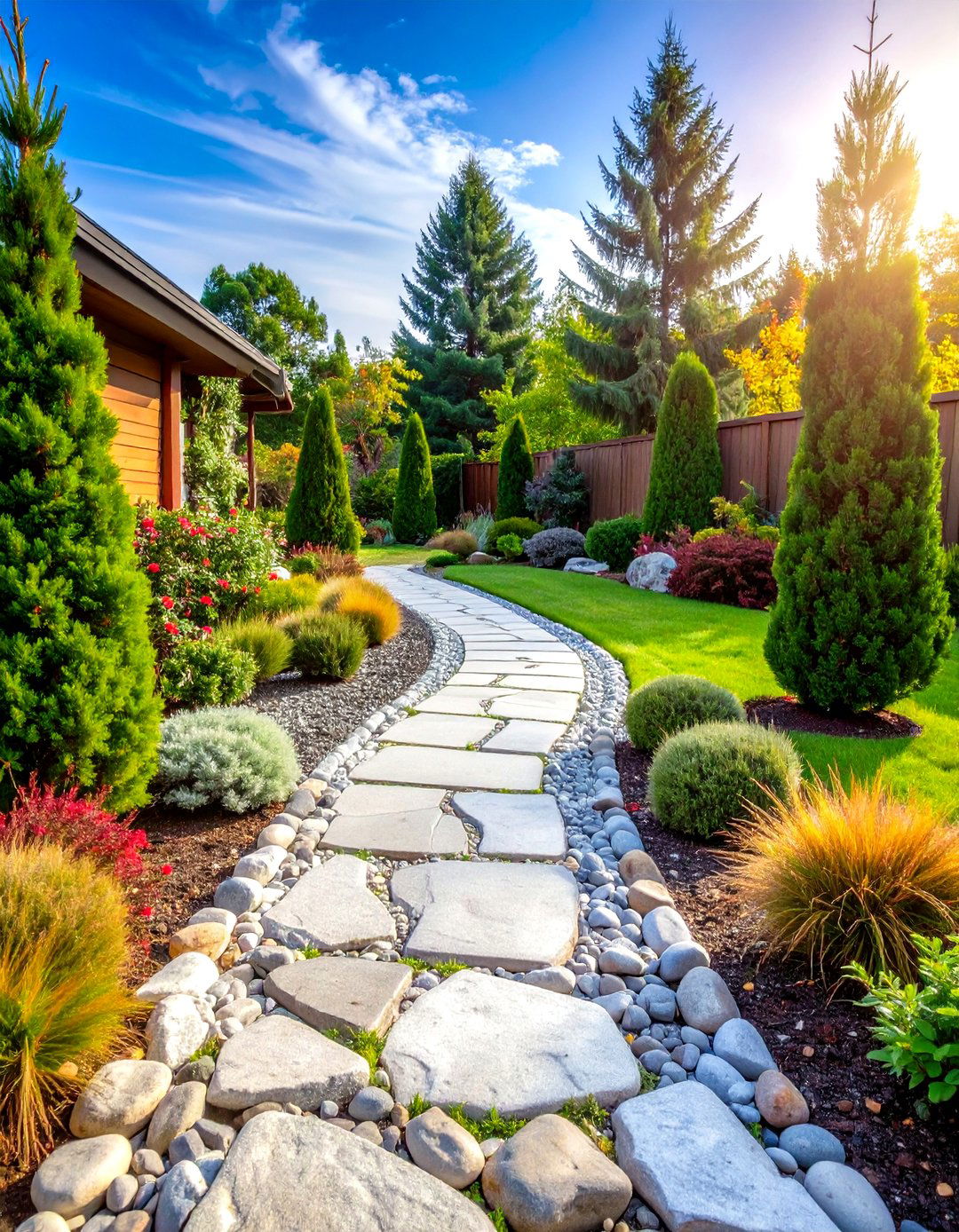
Lining a walkway with pine trees and other evergreens ensures the area is constantly full of new life and abundance of lush color. Create inviting pathways that guide visitors through your landscape while providing structure and year-round interest. Break up the monotony of pathways with strategically placed pine trees that add visual interest with textured trunks and spindly branches. Creating pathway borders not only beautifies your yard but also sets the stage for accent groupings. Gardeners are turning to more natural materials like mulch or branches from trees to line pathways instead of gravel. Choose compact pine varieties that won't overwhelm walkways while providing consistent screening and definition. The Pencil Point Juniper grows thin and stands about five feet tall, making it ideal for lining property or bringing refinement to garden beds. This design creates natural corridors that connect different areas of your landscape while maintaining cohesive evergreen structure.
20. Pine Tree Cottage Industry Herb Garden
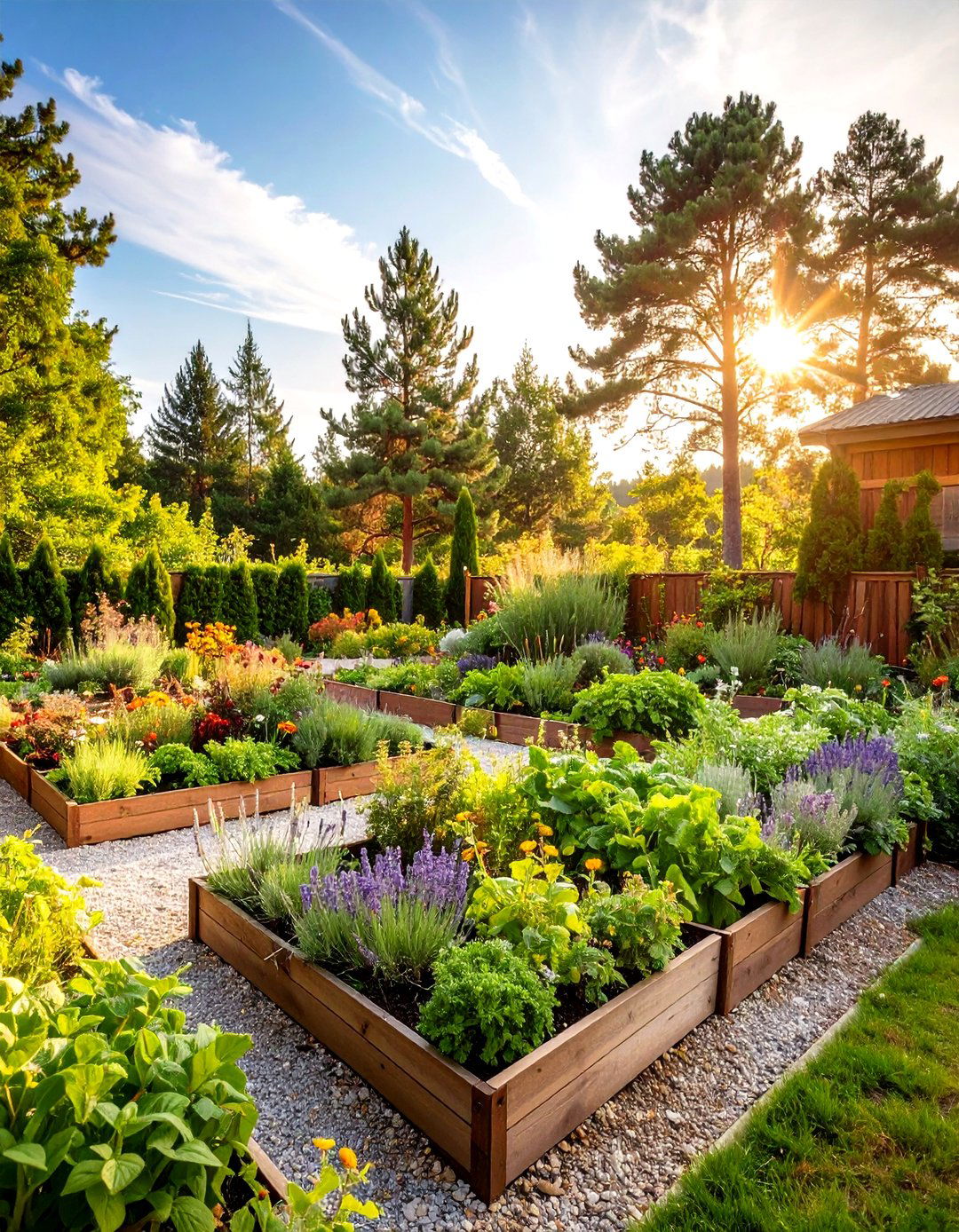
Incorporating edible plants into landscaping adds functionality and supports sustainable living. Design a productive landscape that combines aromatic pine trees with culinary herbs and edible plants for both beauty and function. Turn part of your yard into an edible garden with herbs, small fruit trees and vegetables. Edibles like oregano, rosemary, and lemongrass are excellent choices that contribute to overall beauty and diversity. Incorporate fragrant herbs like lavender and cilantro in weathered terracotta pots for rustic atmosphere. Use pine trees as backdrop elements that provide wind protection for delicate herbs while creating microclimates. Rosemary is a fragrant herb that adds texture to your garden and can be used in cooking. Arrange herbs in accessible raised beds with natural wooden elements for easy harvesting. This design celebrates the connection between landscape beauty and practical function, creating a working garden that provides fresh ingredients while maintaining aesthetic appeal throughout the seasons.
Conclusion:
Pine trees offer exceptional versatility in landscape design, adapting seamlessly to diverse styles from traditional Japanese gardens to contemporary xeriscape installations. Trees are sustainability powerhouses, valuable real estate assets, and landscape design Swiss Army knives. These evergreen champions provide year-round structure, natural privacy, and timeless beauty while supporting local ecosystems and wildlife. Whether you choose cloud-pruned specimens for meditation gardens or drought-tolerant varieties for water-wise landscapes, pine trees deliver lasting value through minimal maintenance requirements and maximum visual impact. A well-designed landscape can enhance curb appeal and increase property value while reducing maintenance needs. Success lies in matching appropriate pine varieties to your specific climate, soil conditions, and design goals, creating landscapes that evolve beautifully over time while providing sustainable, low-maintenance solutions for modern outdoor living.


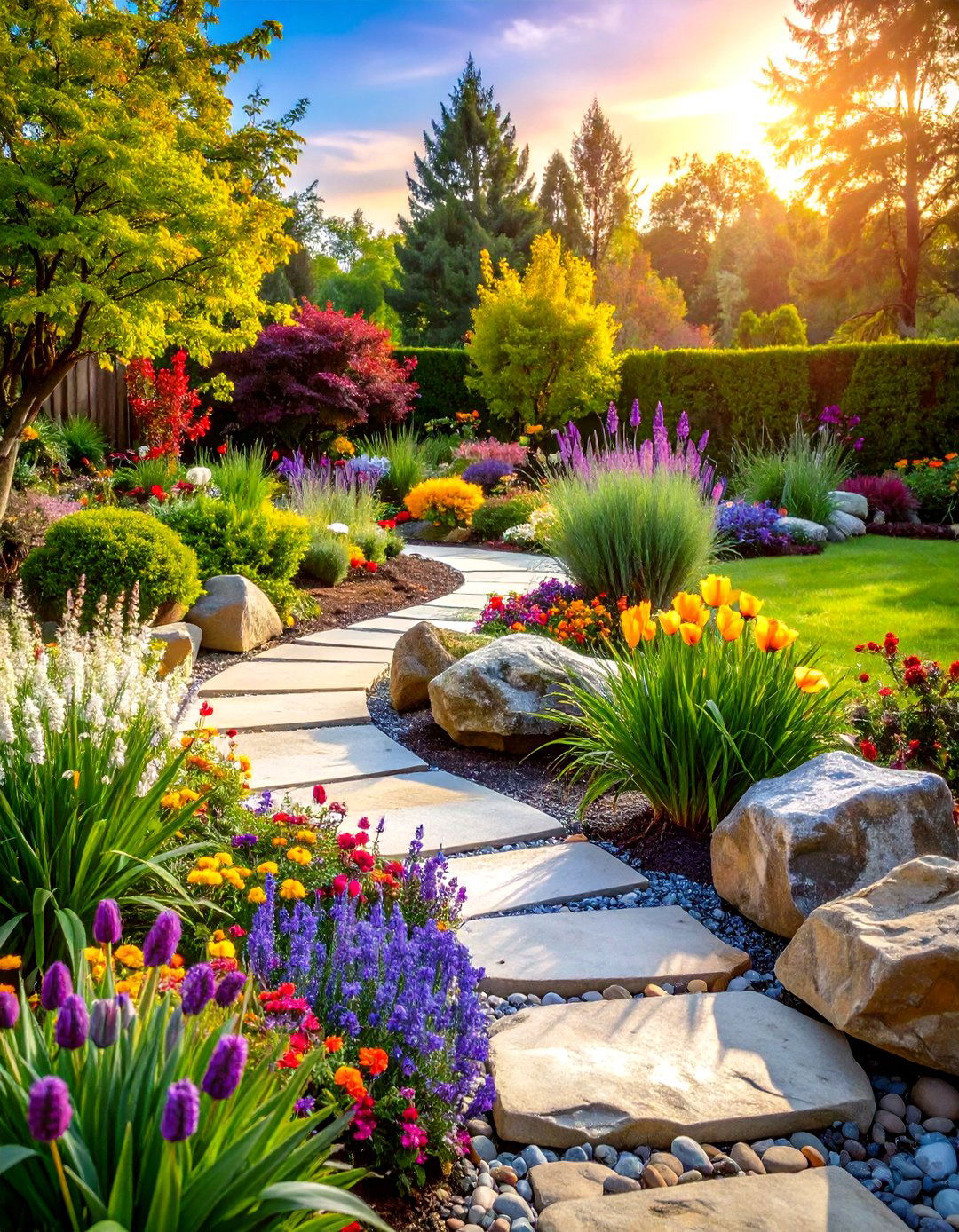
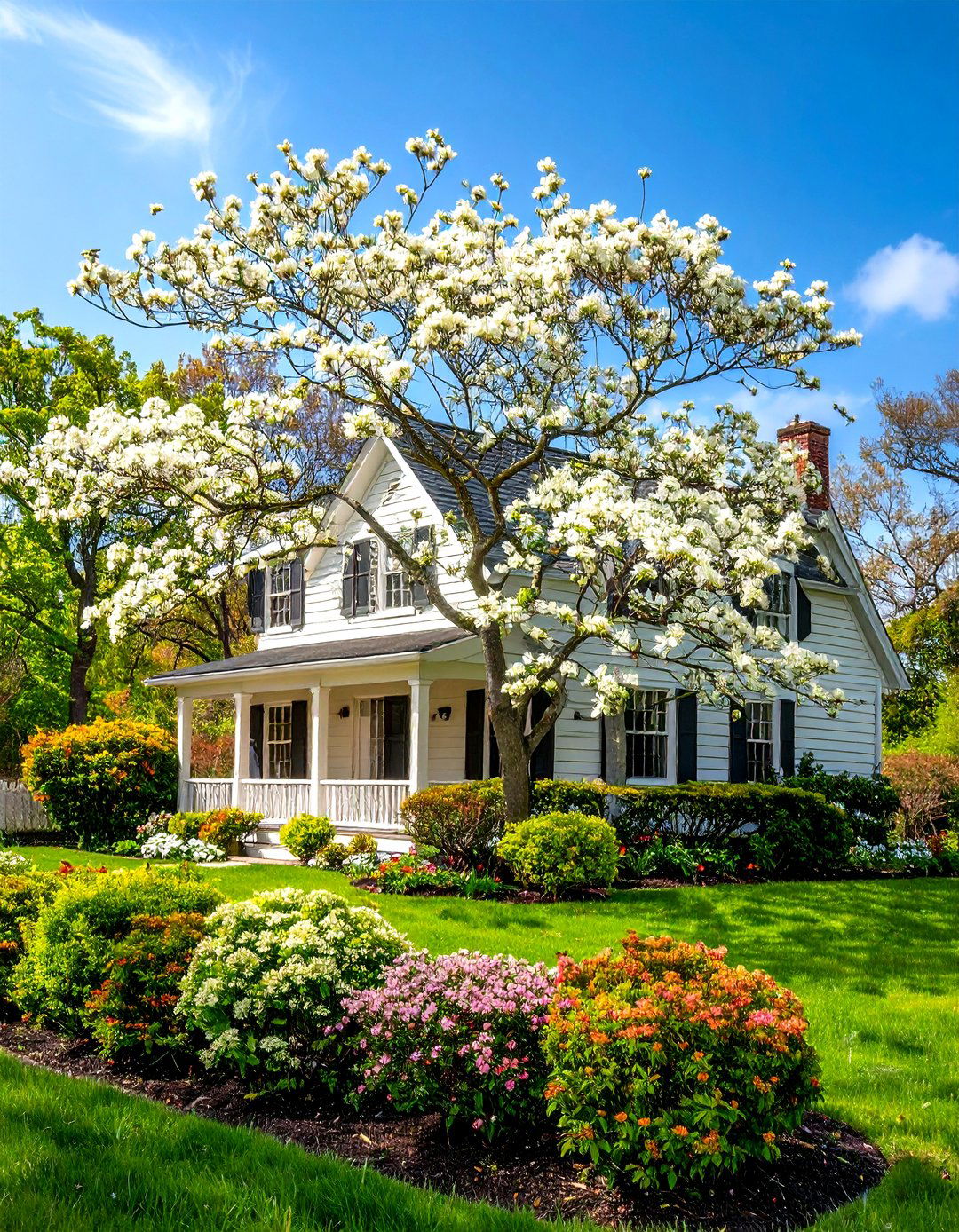


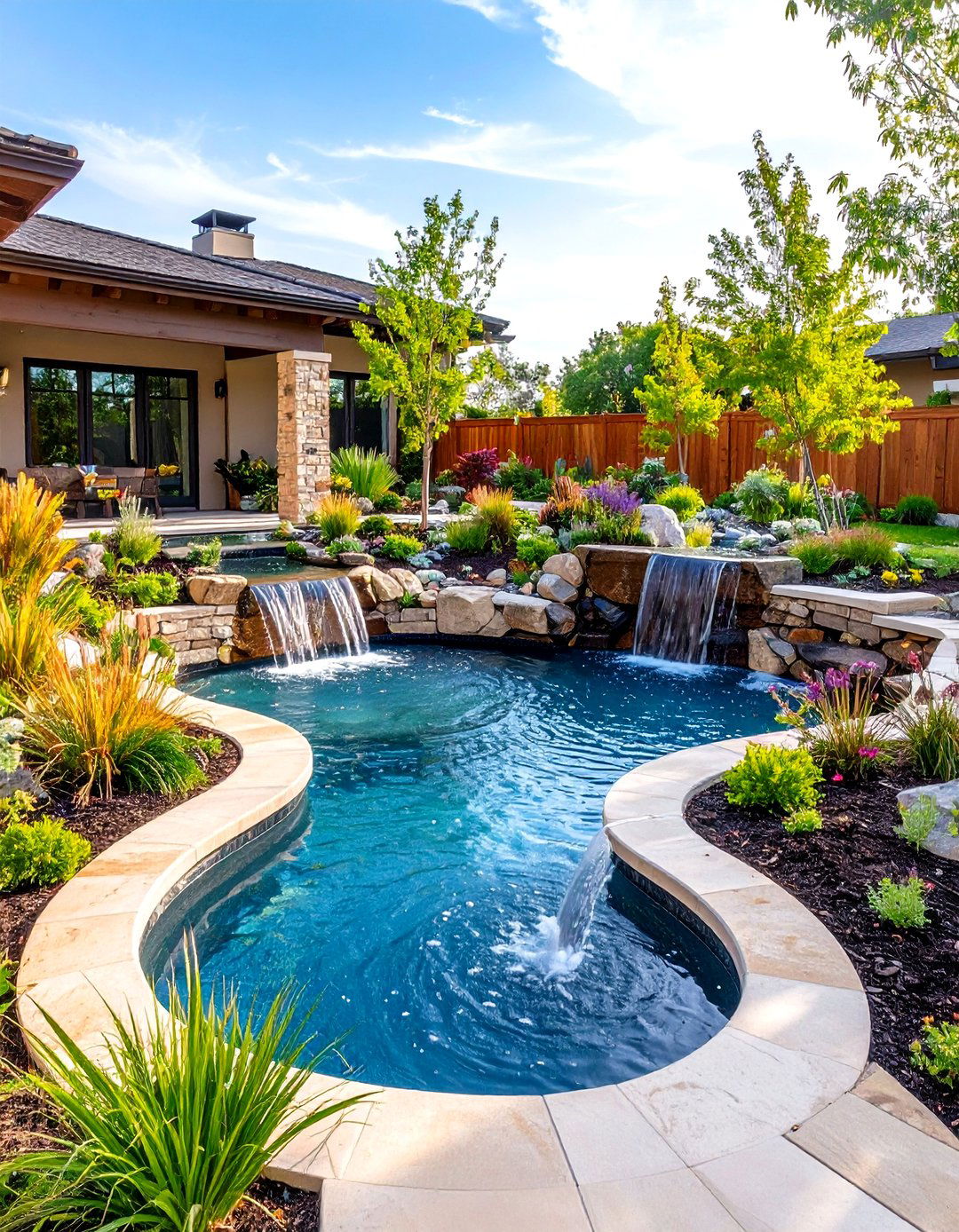
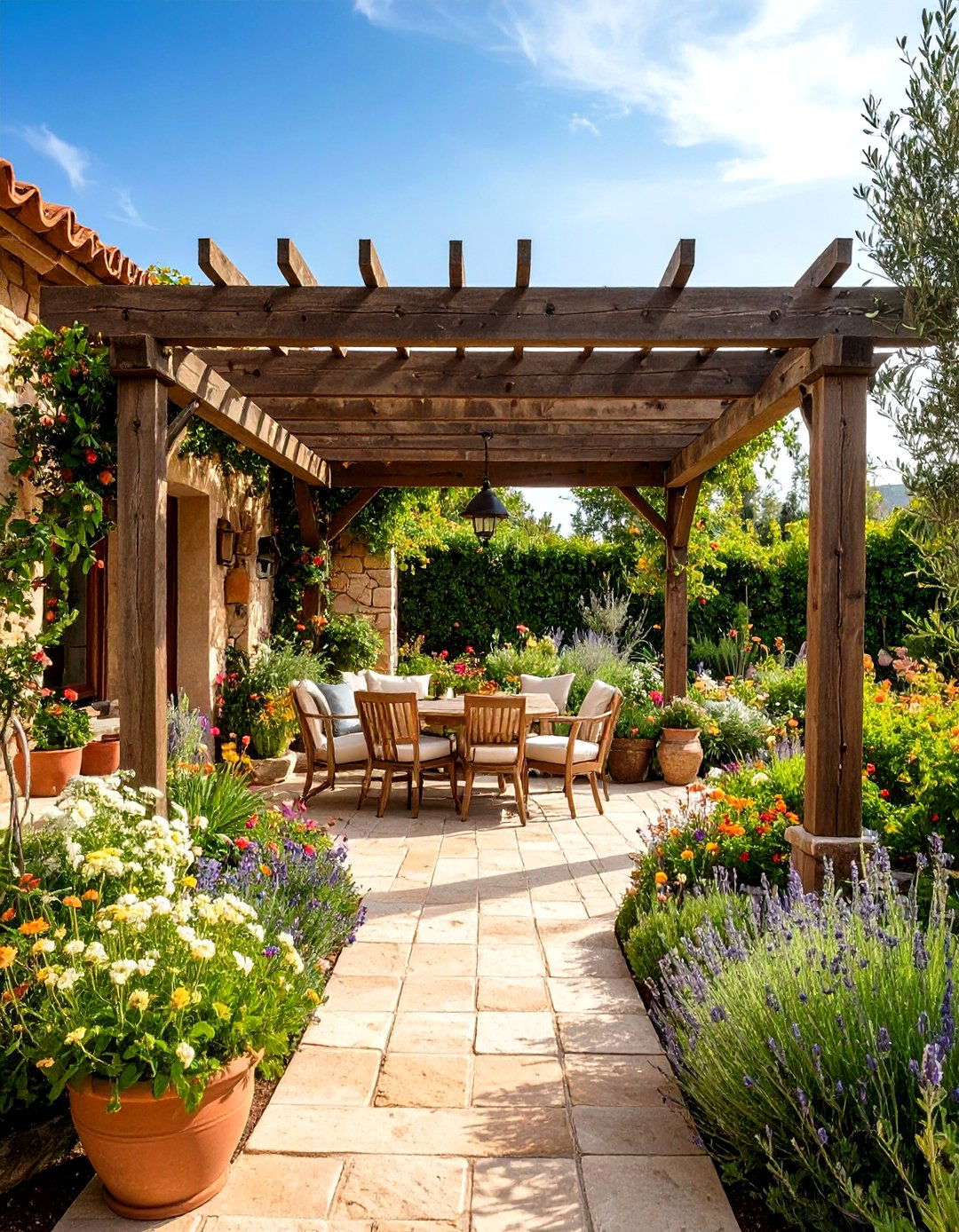
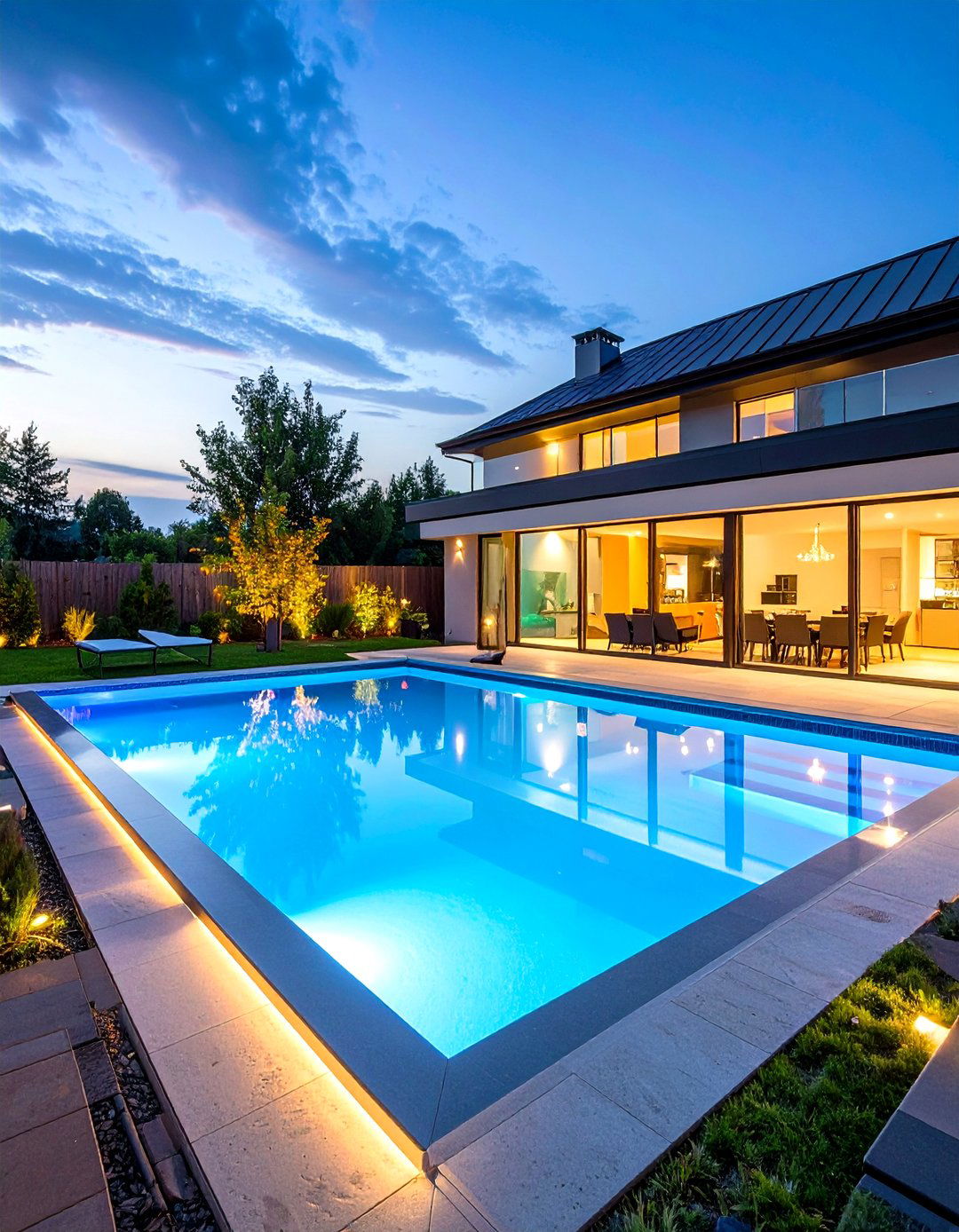
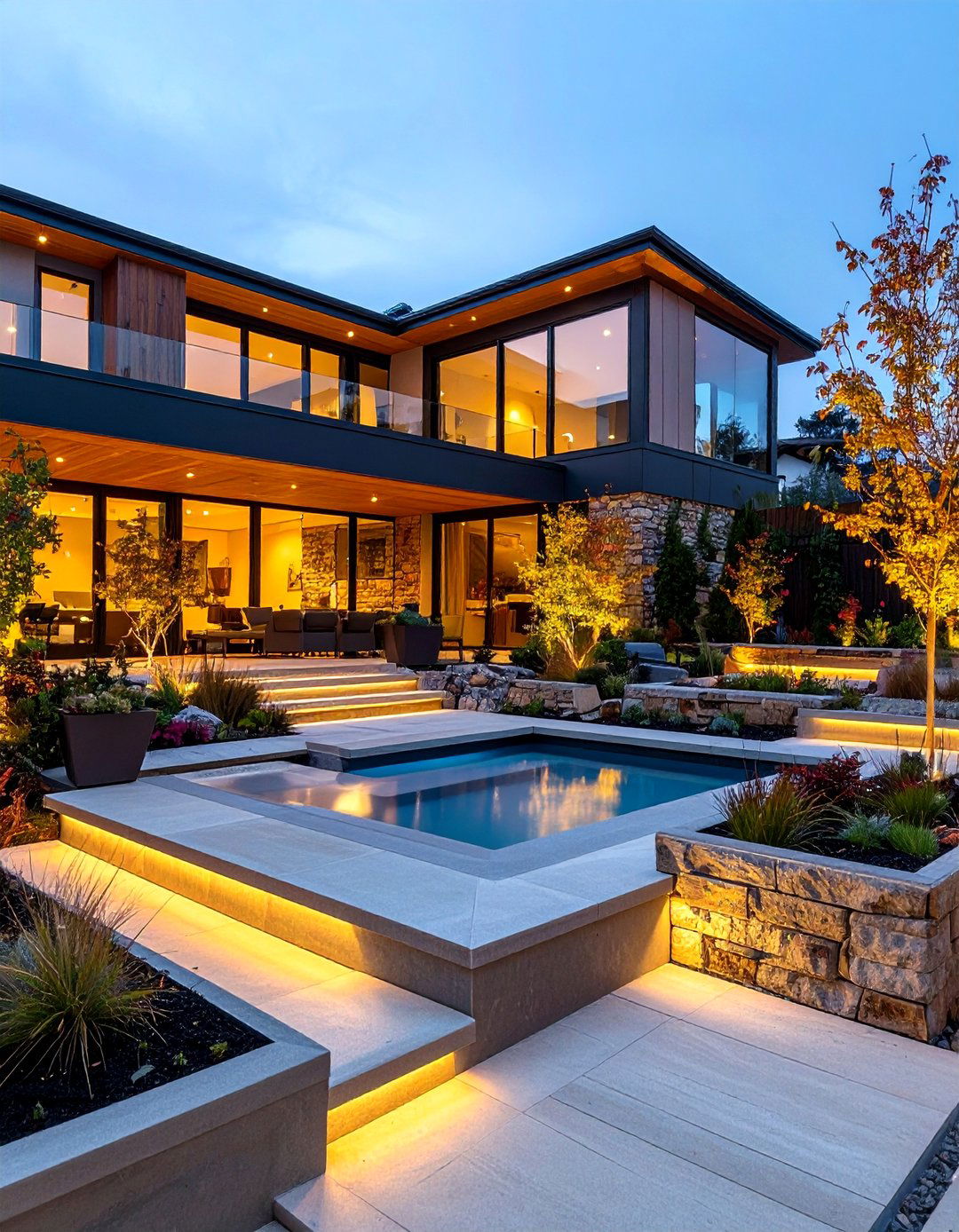

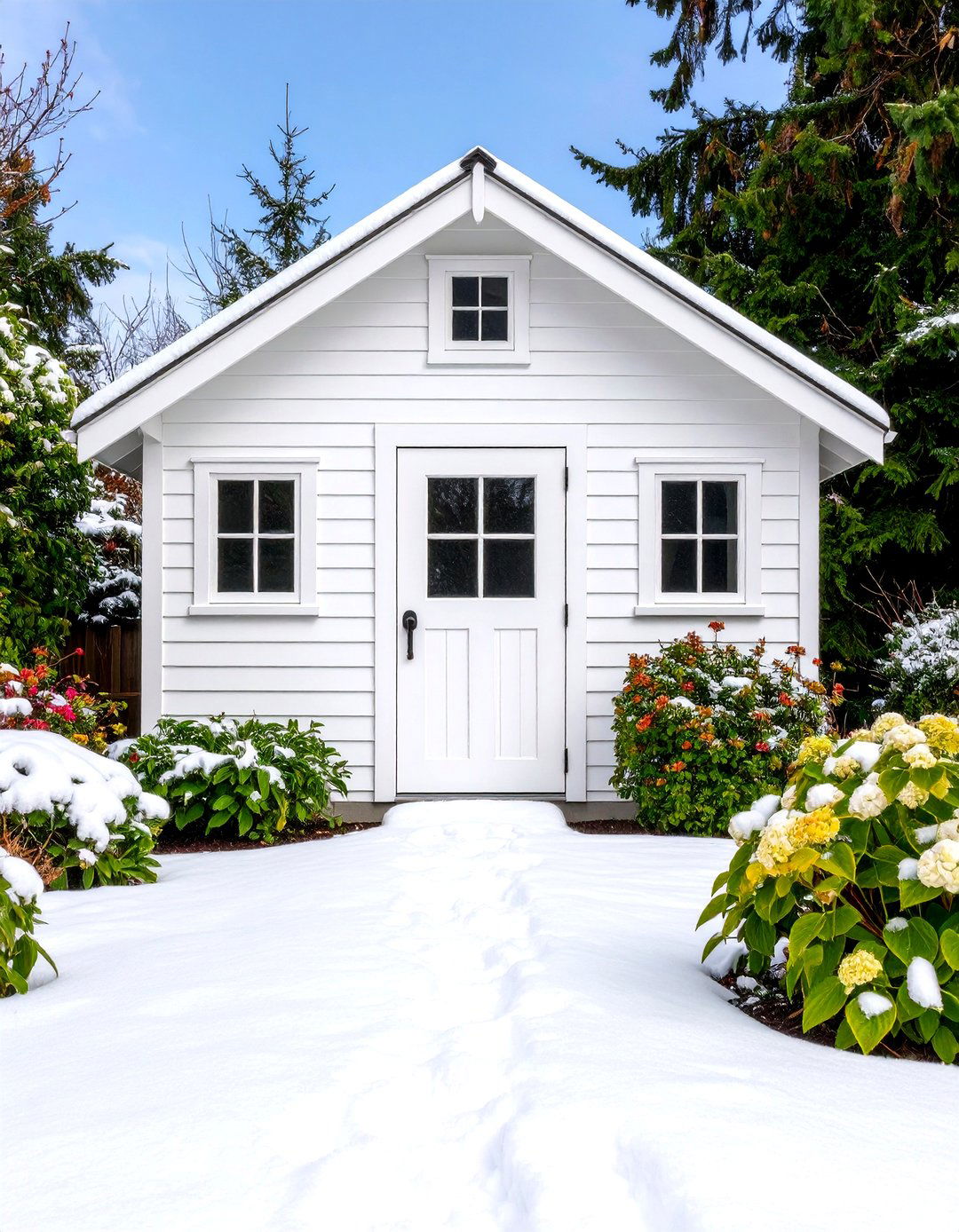
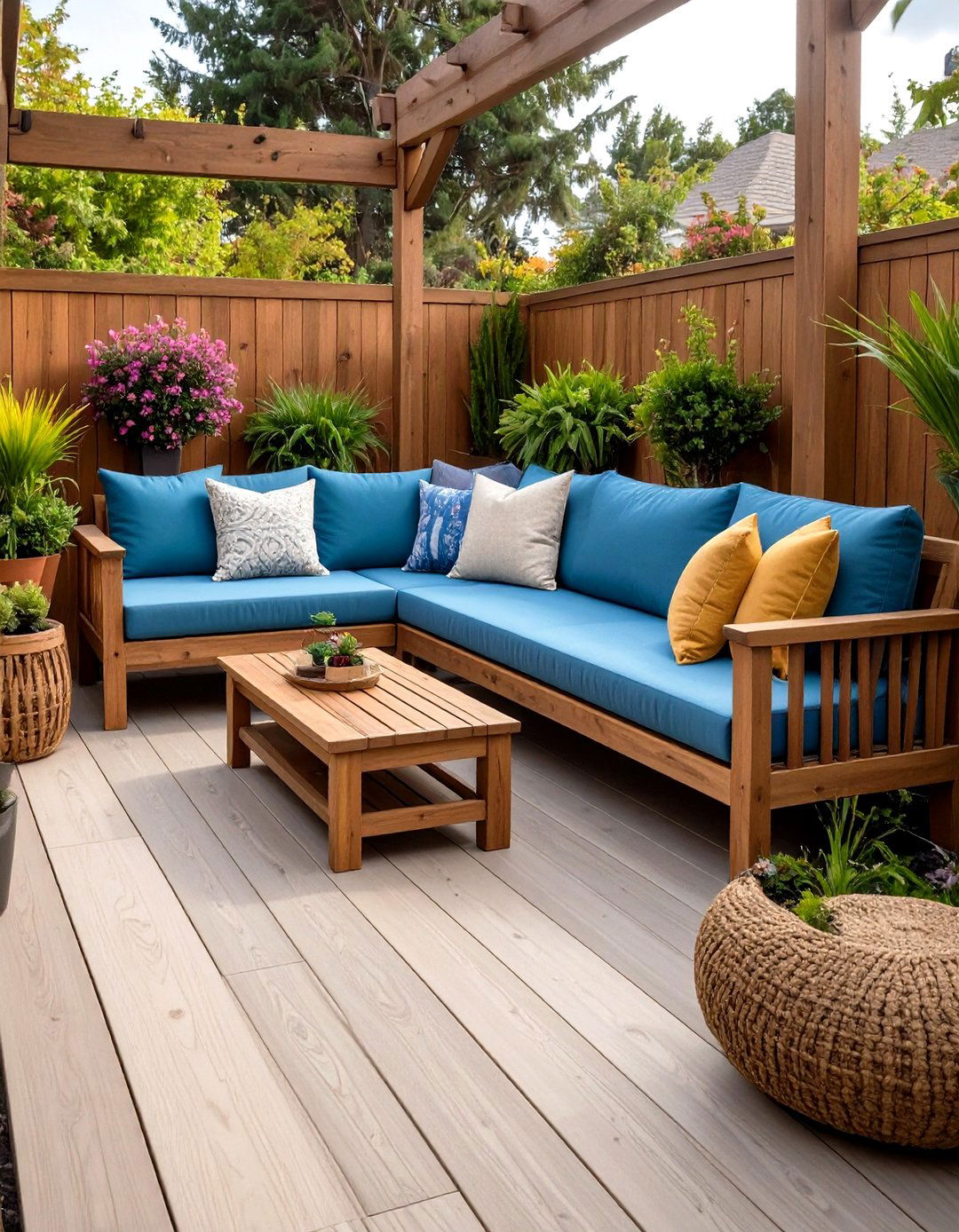

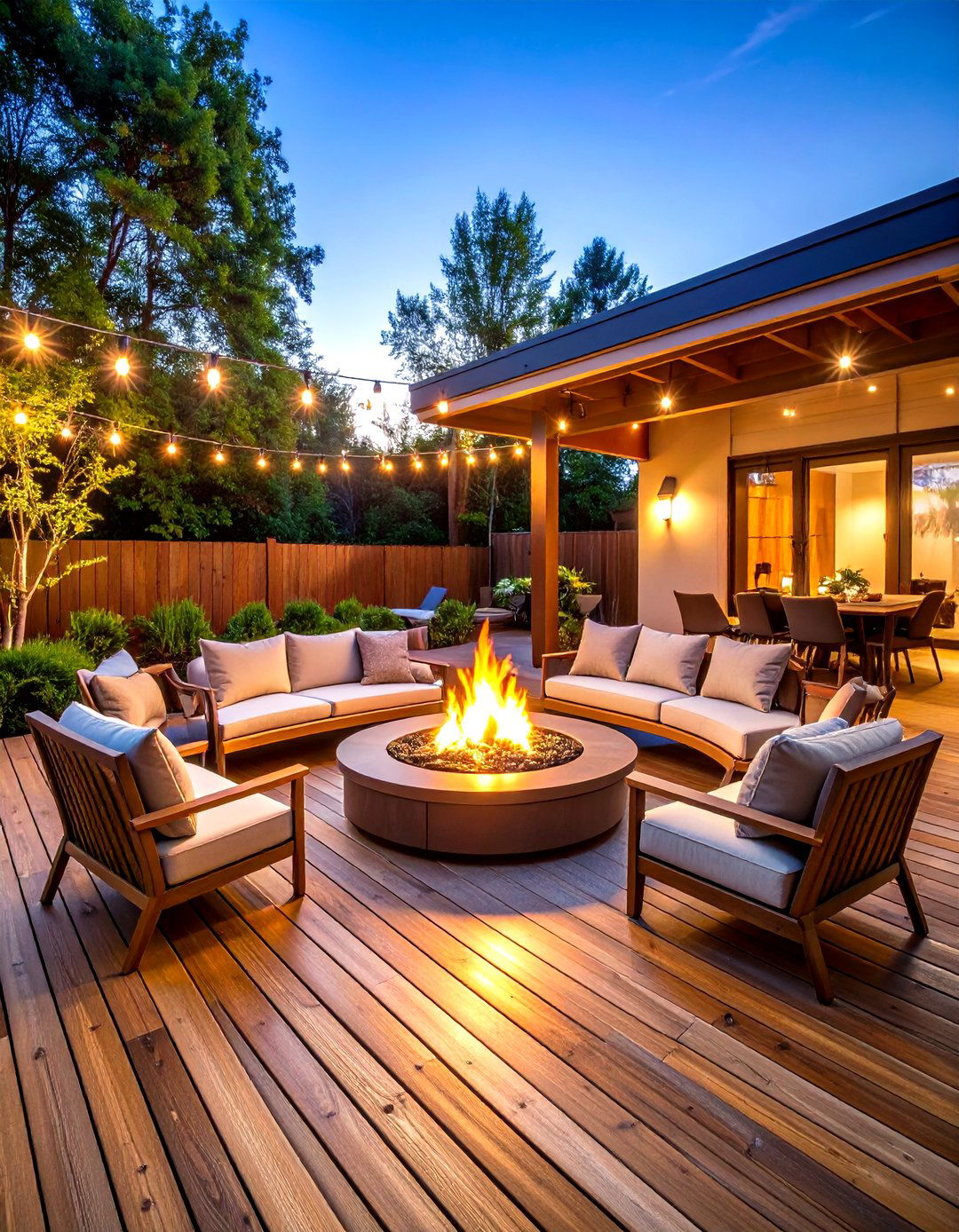
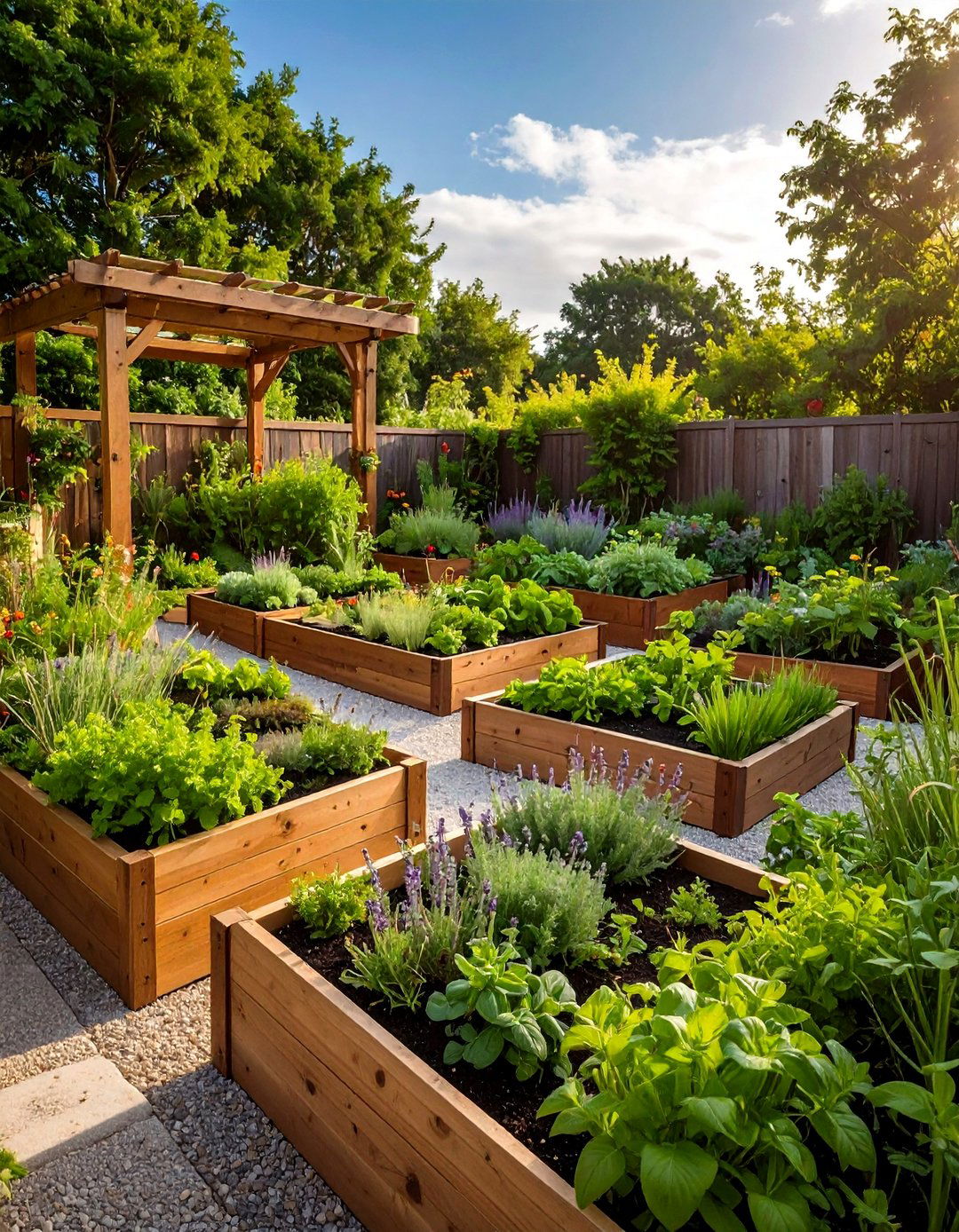
Leave a Reply